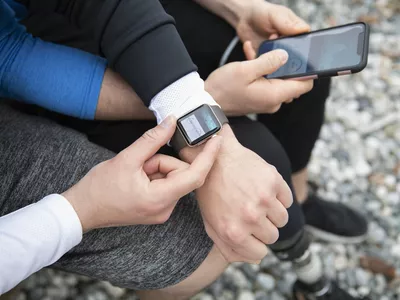
Updated In 2024, Step-by-Step Guide How to Translate TikTok Videos

Step-by-Step Guide: How to Translate TikTok Videos
TikTok has become a global sensation in today’s digital age. Their short-form video content has transformed the social media landscape. It has become one of the most popular social media platforms, with millions of users worldwide.
To maximize engagement reach, creators can now translate TikTok videos into different languages and expand their audience. If you are curious, we’ll delve into how to translate TikTok videos in this article.

Part 1. Why Do Creators and Brands Need to Translate TikTok Videos
TikTok’s translation feature helps users understand content in different languages. It translates captions and text from one language to another. Hence, everyone can enjoy the videos. To use the translation feature, tap “See translation” at the bottom of the screen. The app will translate the captions into your device’s language.
Here are more reasons why it’s important:
Reaching New Markets
TikTok translatebreaks language barriers. Helping you reach new audiences who may not understand your content otherwise. This feature makes it easier to connect with them. And leading to more engagement and potential leads.
Enhancing Rankings
Translating content broadens its reach, leading to increased engagement and popularity. This feature, in turn, can improve its ranking on search engines. Higher rankings mean more visibility and traffic. This means more conversions, especially if the video is embedded on your website.
Improving TikTok Advertising
When running ads, the translation tool allows targeting audiences in other languages. This feature eliminates language barriers and expands your ad reach. Potential increasing ad effectiveness and reaching a wider audience.
Boosting Sales Conversions
Adding captions to videos increases impressions by over 55%. As a business owner, captions help. With the translation tool, more people from different backgrounds can understand your content. This feature will enhance the viewing experience. Potential in boosting their chances of buying your product.
Part 2. How to Translate TikTok Videos to English with Auto-Translate Feature
In 2022, TikTok introduced translation tools to break down language barriers. Making content more accessible to all users. The main components of TikTok’s translation tool include captions and description translation, auto-generated video captions, and sticker translation.
1. Captions and description translation
This feature allows users to auto-translate captions and descriptions. Therefore, users can enjoy TikTok videos in languages other than their own. For instance, if you want totranslate a TikTok video to Englishfrom Japanese captions. You can follow these steps:
- Step 1. Go to your profile, then click the three strips at the top of the screen.

- Step 2. Open Settings and Privacy

- Step 3. Go to Language under the Content & Activity section

- Step 4. Toggle on Always Show Translations

Once selected, you can translate captions and descriptions of videos in different languages. You can click “See Translation” when watching TikTok’s videos.
2. Auto-generated video captions
This feature allows viewers to enable closed captions for videos they’re watching. And eliminate the need for creators to add captions manually. The auto-generated captions appear above the video creator’s name on the For You Page. Captions will appear once you tap them.

3. Sticker Translation
This feature enables the translation of text stickers. Stickers are the text overlays you see while watching a video. With this feature, you can understand the text stickers that are using other languages.
These translation features facilitate communication across language barriers. Accessing content from around the world becomes easier. Regardless of one’s language or geographical location. You can go to this link for more detailed information about auto-translate tools.
Part 3. How to Translate TikTok Videos into Any Language with AI Video Translator
TikTok’s auto-translation feature has a limited range of languages. They only allow auto-translation within captions. Wondershare Virbo offers a solution to enhance your experience beyond the platform’s features. TikTok video translator by Wondershare Virbo is a tool that enables users to make their TikTok videos speak in different languages. By using this tool, you can also add subtitles to the videos.
Here is the step-by-step guide how to translate TikTok video using Virbo’s AI Video Translator tool:
- Step 1. Go to Wondershare Virbo official website and select Generate AI Video Online.

Get Started Online Free Download
- Step 2. Create an account or log-in

- Step 3. Once you land on the Virbo homepage, go to Video Translate

- Step 4. Upload the video you want to translate
In the Video Translator interface, upload the video file you want to translate. Then, select the original video language and the preferred target language. You can also activate the Lip Sync feature to ensure the accuracy of audio translation with the video’s lip movements.

- Step 5. Click “Translate this video” to start the translation process. Virbo AI will seamlessly translate the audio and synchronize it with the video. Depending on the video’s length and complexity, the process may take some time to complete.
Conclusion
In conclusion, using Virbo’s Translator tool to translate TikTok videos has many benefits. It helps creators reach more people and engage with diverse audiences worldwide. As we look to the future of making content on TikTok, tools like Virbo’s Translator tool will be super necessary. They’ll help break down language barriers and make content accessible to everyone.
TikTok has become a global sensation in today’s digital age. Their short-form video content has transformed the social media landscape. It has become one of the most popular social media platforms, with millions of users worldwide.
To maximize engagement reach, creators can now translate TikTok videos into different languages and expand their audience. If you are curious, we’ll delve into how to translate TikTok videos in this article.

Part 1. Why Do Creators and Brands Need to Translate TikTok Videos
TikTok’s translation feature helps users understand content in different languages. It translates captions and text from one language to another. Hence, everyone can enjoy the videos. To use the translation feature, tap “See translation” at the bottom of the screen. The app will translate the captions into your device’s language.
Here are more reasons why it’s important:
Reaching New Markets
TikTok translatebreaks language barriers. Helping you reach new audiences who may not understand your content otherwise. This feature makes it easier to connect with them. And leading to more engagement and potential leads.
Enhancing Rankings
Translating content broadens its reach, leading to increased engagement and popularity. This feature, in turn, can improve its ranking on search engines. Higher rankings mean more visibility and traffic. This means more conversions, especially if the video is embedded on your website.
Improving TikTok Advertising
When running ads, the translation tool allows targeting audiences in other languages. This feature eliminates language barriers and expands your ad reach. Potential increasing ad effectiveness and reaching a wider audience.
Boosting Sales Conversions
Adding captions to videos increases impressions by over 55%. As a business owner, captions help. With the translation tool, more people from different backgrounds can understand your content. This feature will enhance the viewing experience. Potential in boosting their chances of buying your product.
Part 2. How to Translate TikTok Videos to English with Auto-Translate Feature
In 2022, TikTok introduced translation tools to break down language barriers. Making content more accessible to all users. The main components of TikTok’s translation tool include captions and description translation, auto-generated video captions, and sticker translation.
1. Captions and description translation
This feature allows users to auto-translate captions and descriptions. Therefore, users can enjoy TikTok videos in languages other than their own. For instance, if you want totranslate a TikTok video to Englishfrom Japanese captions. You can follow these steps:
- Step 1. Go to your profile, then click the three strips at the top of the screen.

- Step 2. Open Settings and Privacy

- Step 3. Go to Language under the Content & Activity section

- Step 4. Toggle on Always Show Translations

Once selected, you can translate captions and descriptions of videos in different languages. You can click “See Translation” when watching TikTok’s videos.
2. Auto-generated video captions
This feature allows viewers to enable closed captions for videos they’re watching. And eliminate the need for creators to add captions manually. The auto-generated captions appear above the video creator’s name on the For You Page. Captions will appear once you tap them.

3. Sticker Translation
This feature enables the translation of text stickers. Stickers are the text overlays you see while watching a video. With this feature, you can understand the text stickers that are using other languages.
These translation features facilitate communication across language barriers. Accessing content from around the world becomes easier. Regardless of one’s language or geographical location. You can go to this link for more detailed information about auto-translate tools.
Part 3. How to Translate TikTok Videos into Any Language with AI Video Translator
TikTok’s auto-translation feature has a limited range of languages. They only allow auto-translation within captions. Wondershare Virbo offers a solution to enhance your experience beyond the platform’s features. TikTok video translator by Wondershare Virbo is a tool that enables users to make their TikTok videos speak in different languages. By using this tool, you can also add subtitles to the videos.
Here is the step-by-step guide how to translate TikTok video using Virbo’s AI Video Translator tool:
- Step 1. Go to Wondershare Virbo official website and select Generate AI Video Online.

Get Started Online Free Download
- Step 2. Create an account or log-in

- Step 3. Once you land on the Virbo homepage, go to Video Translate

- Step 4. Upload the video you want to translate
In the Video Translator interface, upload the video file you want to translate. Then, select the original video language and the preferred target language. You can also activate the Lip Sync feature to ensure the accuracy of audio translation with the video’s lip movements.

- Step 5. Click “Translate this video” to start the translation process. Virbo AI will seamlessly translate the audio and synchronize it with the video. Depending on the video’s length and complexity, the process may take some time to complete.
Conclusion
In conclusion, using Virbo’s Translator tool to translate TikTok videos has many benefits. It helps creators reach more people and engage with diverse audiences worldwide. As we look to the future of making content on TikTok, tools like Virbo’s Translator tool will be super necessary. They’ll help break down language barriers and make content accessible to everyone.
How to Translate Audio/Video Content from Spanish to English and vice versa?
Spanish is one of the world’s most popular languages. According to a report by the Cervantes Institute, it has approximately 496 million native and 595 million total speakers. Spanish speakers comprise approximately 7.7 percent of the world’s population. So if you want to reach such a broader population but know only English, video, and voice Spanish translators are your best bet. You can use them to convert your content from one language to another with ease. In this article, we will reveal 3 of the top tools that can translate Spanish sound to English or vice versa. Stay tuned!
Part 1. Top 3 Tools to Translate Spanish Voice to English
1. Wondershare Virbo
Translate Online Free Download
Wondershare’s Virbo is a wonderful AI tool for videos. Among other features, it lets you translate Spanish sound to English and vice versa. Simply upload your video or audio. Virbo’s advanced AI algorithm automatically detects the voice, translates it into another language, and synchronizes the dubbing accordingly. Doing so eliminates the hassle of creating overdubs later.
Unique Features of Virbo Voice Spanish Translator
- Translates from Spanish to English and English to Spanish, or translate Spanish to any other 30+ languages
- Transcribes audio to text automatically and lets you proofread and download subtitles
- Supports 2 major file formats: MP4 and Mov
- Fast, efficient, and easy to use for everyone
Translate Online Free Download
2. Notta.AI
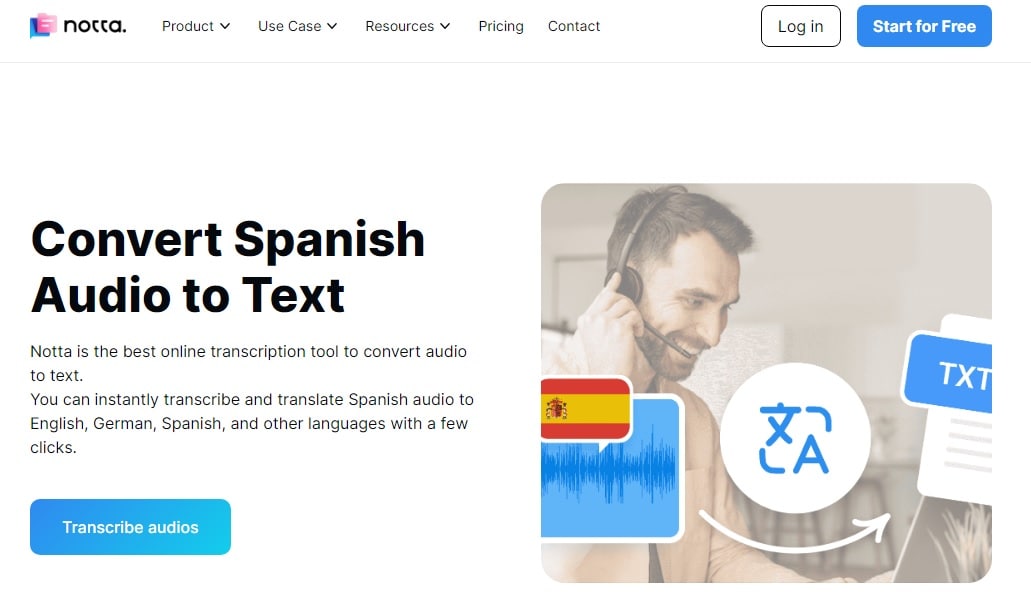
Notta is the new talk of the town. This Spanish to English voice translator (and English to Spanish translator) provides a natural voice and accent to translate your videos and stand out from the crowd. With an impressive transcription efficiency of 98.86, you can trust Notta to provide highly reliable and accurate translations. Using Notta is simple, too. Just drag and drop your video on the Notta dashboard, select Spanish if you’re translating an English video, and hit generate. It will generate English text. You can then translate it into Spanish language and dub it over the video.
Unique Features of Notta AI Spanish Translator
- Can translate any type of video from Spanish to English
- Can translate 2 hours of audio in 5 minutes
- Supports all major file types: WAV, MP3, M4A, CAF, AIFF, AVI, RMVB, FLV, and WMV, etc.
- Offers a range of export options, including SRT, subtitle file
- This Spanish to English audio translator is suitable for Live Events as well
3. Maestra.AI
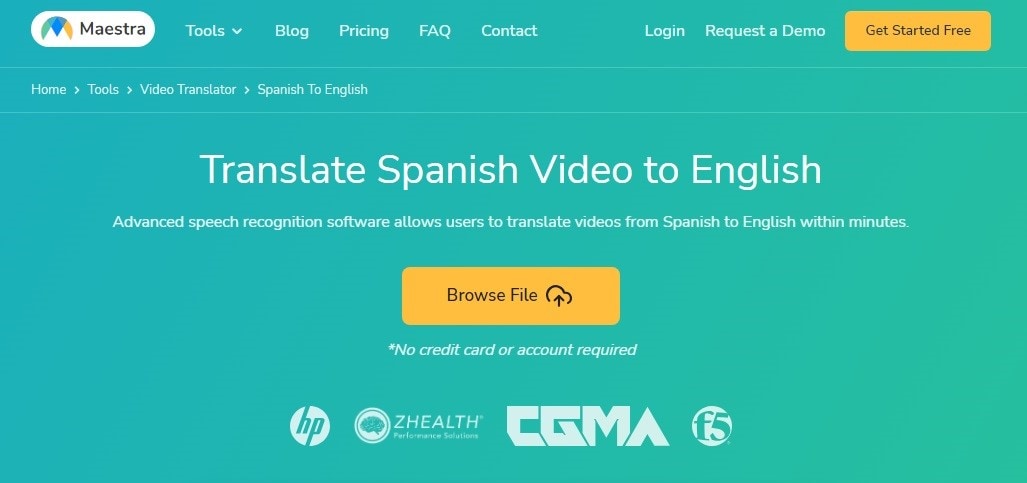
Maestra.a is another excellent option. Unlike others, it’s an online spanish video translator. This means you do not need to download software and install it on your PC. You can upload your video to the Maestra cloud, translate it online, and access it anywhere. Moreover, Maestra also supports Dropbox, Google Drive, Instagram, and YouTube. So you can just provide it a link to your video instead of uploading anything.
Unique Features of Maestra.ai Video Translator
- Supports 80+ languages, including Spanish, for translations
- Online translation and online storage for easy access
- Automatic subtitles and voiceover generation
- Works with online links from YouTube, Dropbox and Google Drive among others.
- Lets you edit your text before exporting
Part 2. Step Guidance: Translating between English and Spanish
Below is step-by-step guidance to help you to translate Spanish sound to English, or vice versa.
Note: We will be using Wondershare Virbo for this purpose.
Step 1 Install Virbo
Download and Install Virbo AI video translator on your computer or your phone. Now launch it and go to the Video Translator tool.
Translate Online Free Download
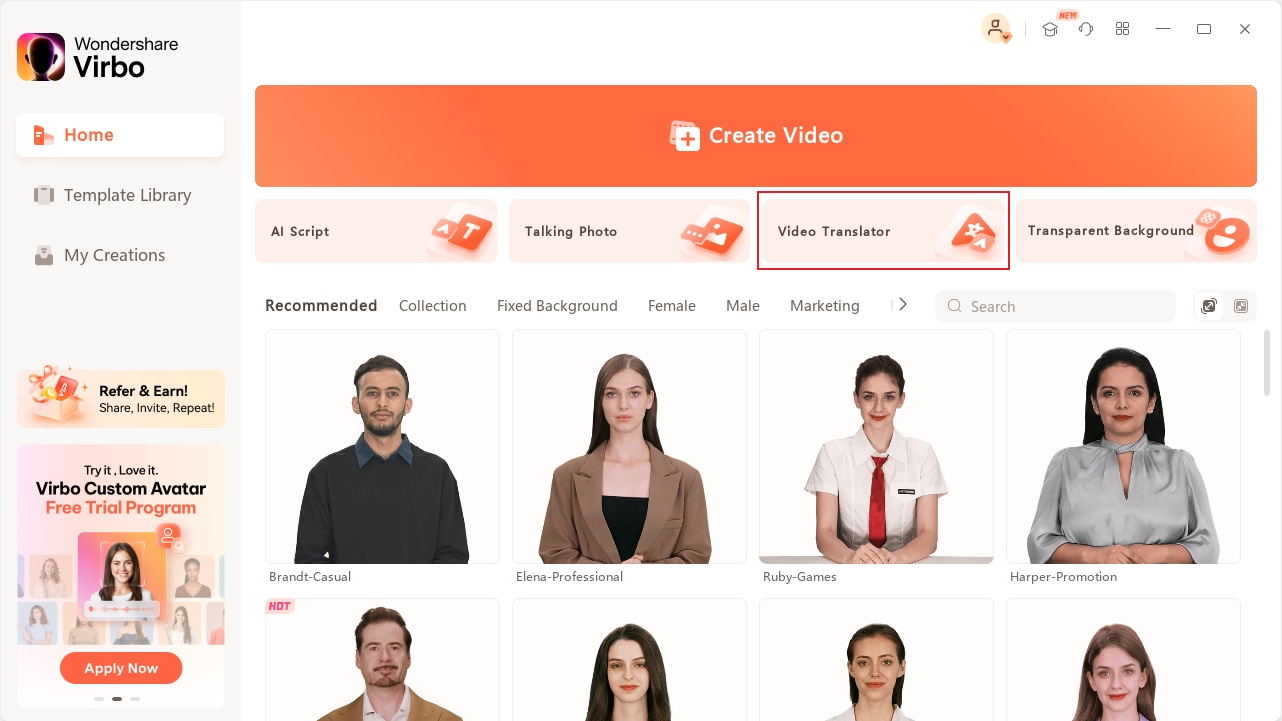
Step 2 Upload your video
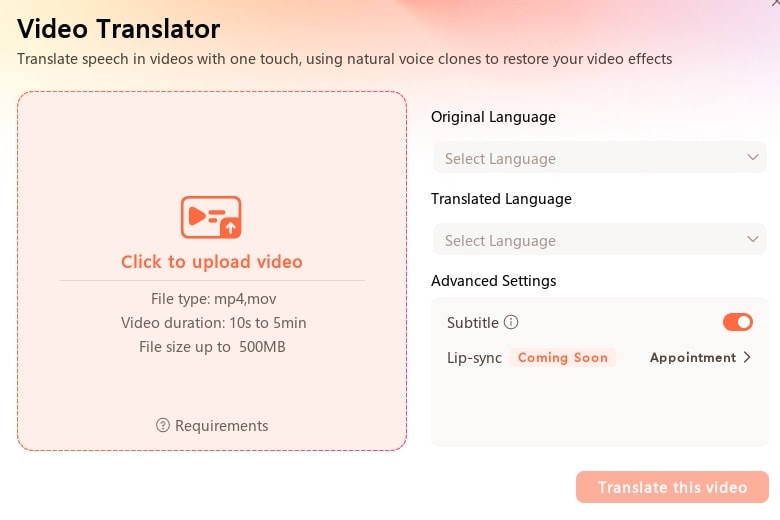
Note: Uploading may take some time, depending on the size of your video.
Step 3 Change settings and set your target language
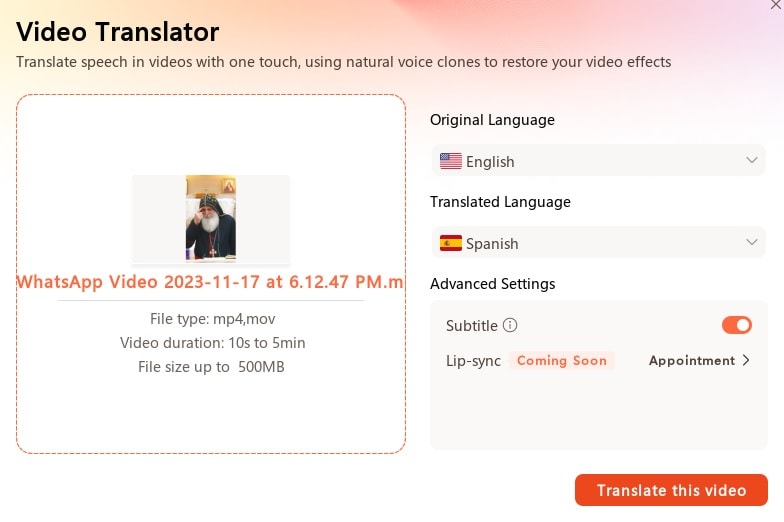
Note: if you are translating from English to Spanish, Spanish will be your Translated Language.
Step 4 Translate your video
Once the translation finishes, hit the orange Translate this video button. Virbo will translate your audio and present the file for downloading.
Translate Online Free Download
Part 3. Guidelines for Creating Accurate Spanish Translation
01of 10Understand the Context
Most AI translation tools lack contextual understanding. Make sure the translated text provides complete sentences or phrases without skipping any important detail.
02of 10Check the Formality
Spanish has formal and informal forms of address. Make sure the Spanish to English video translation tool reflects the appropriate level of formality based on the context and relationship between the conversing parties.
03of 10Be Mindful of Idioms
Idiomatic expressions in Spanish don’t always have direct equivalents in English. AI tools may struggle with these, so be ready to simplify or rephrase to convey the intended message accurately.
04of 10Review Regional Variations
Spanish varies across regions. For instance, Spanish in Latin America is vastly different from Spanish in Spain. Therefore, you should consider the target audience’s region and adjust translations accordingly, especially for colloquialisms and regional vocabulary.
05of 10Verify Technical Terms
For specialized or technical content, verify that the Spanish video translator understands and translates industry-specific terms correctly. You can provide additional context in the preview if needed.
06of 10Double-Check Tenses
Spanish and English express time differently. Ensure the AI captures the correct tense, especially in complex sentences, to convey the intended temporal meaning accurately.
07of 10Handle Gender Sensitively
Spanish had a binary (masculine/feminine) gender system only, while US English has multiple. Ensure the AI translates gender-sensitive terms appropriately and consistently throughout the text.
08of 10Consider Sentence Structure
Spanish and English have different sentence structures. Verify that the translated text maintains clarity and coherence while respecting the syntactic rules of the target language.
09of 10Proofread and Edit
AI tools may not catch nuanced errors. So, if you want to translate voice/videos from Spanish into any language, proofread the translated text. Check for grammatical accuracy, style, and overall fluency. Make necessary edits to enhance readability.
10of 10Add Human Touch
While AI tools are a great help for translation, they lack the nuanced understanding that humans possess. For critical or sensitive content, consider reviewing the AI-generated translations by a human translator to ensure accuracy and cultural appropriateness
Conclusion
Breaking language barriers in audio/video content is now more accessible than ever. By leveraging a good AI Spanish translation tool like Virbo and following the step-by-step guidance provided above, you can seamlessly translate Spanish audio to English or English voice to Spanish. Remember to adhere to our translation guidelines for crafting accurate translations. Whether you’re a content creator, business professional, or language enthusiast, Spanish audio/video translation opens doors to a world of diverse communication and global reach. Good luck!
Translate Online Free Download
Translate Video From English to Arabic with Ease
Arabic is the sixth most spoken (and understood) language in the world. According to Wikipedia, there are approximately 422 million Arabic speakers (native & non-native). If you are a content creator, translating English videos to Arabic presents an opportunity to reach such a wide audience. In this article, we will present one such tool that can help you translate video to Arabic with ease. We will also discuss common challenges in translating videos to Arabic and how our recommendation overcomes them. So, without further ado, let’s dive in.
Part 1. Common Challenges In Translating English Videos Into Arabic
Below are some common challenges you face when you want to translate videos to Arabic.
Lack of Semantic Nuances
Arabic is a very rich language with semantic nuances. As it exhibits a distinct linguistic structure, taking care of linguistic and cultural nuances is the main challenge in accurately capturing the meaning during translation.
Translating Idiomatic Expressions
Translating Arabic idioms, colloquialisms, and culturally specific expressions is difficult as these may not have direct or indirect equivalents in (say, for example) English. AI tools, in particular fail to accurately translate such sentences.
Considering Sentence Structure Variations
Maintaining coherence and natural flow is essential for effective communication. Arabic follows a very different sentence structure, complicating the translation process. For example, it is written from right to left, therefore, the translation will be read in the opposite direction.
Translating Gender and Formality
Arabic includes gender-specific pronouns and formal/informal distinctions, whereas English is more neutral towards gender. Ensuring appropriate gender and formality in translations is crucial for cultural sensitivity.
Lack of Technical Vocabulary
Technical terms may lack direct equivalents in Arabic. For example, the term “Artificial Intelligence” has no equivalent translation in Arabic. Not all AI tools will translate these terms to accurately convey the meaning. Therefore, we recommend only the best.
Part 2. Best Tool for Translating Videos Into Arabic
Translate Video Online Download APP to Translate Video Now Translate Video on Win
Wondershare Virbo is a groundbreaking tool that takes care of all these challenges while translating videos from Arabic to English and English to Arabic. It uses highly advanced AI machine learning algorithms and language models to analyze the context of a spoken word. It then translates and generates text in the target language. Virbo supports 20+ languages, breaking language barriers and helping you reach a wider audience. The premium plan gives you access to its entire feature set. But if you’re using the free plan, Virbo allows translations of 2-minute videos and 500 Mb files. Unfortunately, Virbo doesn’t work with YouTube links. So, if you want to translate YouTube video to Arabic, you have to download it first.
Unique Features of Virbo AI Video Translator
- Can translate video to Arabic free
- Supports 20+ Language
- Highly accurate and concise translations
- Auto-generate scripts if necessary
- AI Voice Cloning feature for Live Videos
- The lip sync precision feature is supported
Limitation
- Cannot translate YouTube videos to Arabic directly from the link (you have to download it first)
Compatibility
Wondershare Virbo is available on the following platforms:
- Windows - You can install Virbo software on your Windows computer/laptop
- Android - You can get Virbo android app from the official Google Appstore
- iOS - You can download Virbo on Apple iOS devices like iPhones and iPads
- Online - You can translate YouTube video to Arabic online
Language Support
Currently, Virbo supports the following languages:
Original Language: English, Chinese, Spanish, Arabic, Portuguese, Indonesian, French, Russian, German, Japanese, Italian, Korean, Thai, Filipino, Bengali, Turkish, Dutch, Swedish, Croatian, Romanian, Czech, Hindi, Ukrainian, Vietnamese, Malay, Slovak, Danish, Tamil, Polish, Greek, Finnish, Burmese, Urdu.
Translated Language: English, Spanish, German, Portuguese, Italian, Indonesian, Chinese, Japanese, Arabic, Filipino, Korean, Hindi, Russian, French, Dutch, Turkish, Polish, Swedish, Bulgarian, Romanian, Czech, Greek, Finnish, Malay, Slovak, Danish, Tamil, Ukrainian.
Translate Video Online Download APP to Translate Video Now Translate Video on Win
Part 3. Easy-Follow Steps to Translate Videos Into Arabic
To start translating your videos from English to Arabic, download Virbo from the official Wondershare website or just click the “Translate Video on Win” button below to download Virbo and install this video translator on your computer. You can also use the online tool or its Android or iOS app to do so. Now follow the steps below to translate video from English to Arabic.
Step 1Upload Your Video
Translate Video Online Download APP to Translate Video Now Translate Video on Win
Launch Virbo and go to Video Translator Tool in the top right corner. Now, upload your video.
Note: You can choose any video between 30 seconds to 2 minutes and a 500 MB file size.
Step 2Select Source and Target Language

Once your video finishes uploading, you will see the option to select Source and Target languages. Select English as the source and Arabic as the Target language.
Step 3Generate your translated Video

Click on Generate Video to begin the video translation process. It will take some time so be patient.
When the translation finishes, preview it. If everything is fine, click on Download Video to save your video offline. Easy peasy!
Translate Video Online Download APP to Translate Video Now Translate Video on Win
Part 4. Frequently Asked Questions (FAQs)
01of 04Is Virbo Free?
Yes, Virbo software is free to download and use. It has a free plan that lets you translate 2-minute videos (500 MB max) without costing a dime. The premium plan gives you access to more features and allows longer videos.
02of 04What languages does Virbo support?
Virbo currently supports 20 languages and constantly working to add support for more languages. With Virbo, you can translate to and from these languages with ease. For a complete list, check out the Part 2 section above.
03of 04Does Virbo generate subtitles?
Yes, the Virbo online tool automatically generates subtitles. You can edit and customize them if necessary. It also gives you the option to download subtitles as SRT files once you are done. Note: This feature is only available for the Virbo online tool.
04of 04How accurate is English to Arabic or Arabic to English translation generated by Virbo?
The translation accuracy of Virbo is approximately 98.6%, thanks to the utilization of the latest AI technology. It utilizes advanced machine learning mechanisms to ensure contextually relevant translation. However, there’s still a minor chance of error. So, get some human eyes to review the generated text before finalizing.
Conclusion
Arabic to English and vice versa translation can be a bit tricky for common AI translation tools. However, with the right tool, such as Wondershare Virbo, you can translate YouTube video to Arabic online or offline. This way, content creators can seamlessly bridge any and every language barrier. Embracing these latest solutions enhances accessibility, fosters cross-cultural understanding, and makes video content more inclusive and impactful on a global scale.
Translate Video Online Download APP to Translate Video Now Translate Video on Win
Wondershare Virbo is a groundbreaking tool that takes care of all these challenges while translating videos from Arabic to English and English to Arabic. It uses highly advanced AI machine learning algorithms and language models to analyze the context of a spoken word. It then translates and generates text in the target language. Virbo supports 20+ languages, breaking language barriers and helping you reach a wider audience. The premium plan gives you access to its entire feature set. But if you’re using the free plan, Virbo allows translations of 2-minute videos and 500 Mb files. Unfortunately, Virbo doesn’t work with YouTube links. So, if you want to translate YouTube video to Arabic, you have to download it first.
Unique Features of Virbo AI Video Translator
- Can translate video to Arabic free
- Supports 20+ Language
- Highly accurate and concise translations
- Auto-generate scripts if necessary
- AI Voice Cloning feature for Live Videos
- The lip sync precision feature is supported
Limitation
- Cannot translate YouTube videos to Arabic directly from the link (you have to download it first)
Compatibility
Wondershare Virbo is available on the following platforms:
- Windows - You can install Virbo software on your Windows computer/laptop
- Android - You can get Virbo android app from the official Google Appstore
- iOS - You can download Virbo on Apple iOS devices like iPhones and iPads
- Online - You can translate YouTube video to Arabic online
Language Support
Currently, Virbo supports the following languages:
Original Language: English, Chinese, Spanish, Arabic, Portuguese, Indonesian, French, Russian, German, Japanese, Italian, Korean, Thai, Filipino, Bengali, Turkish, Dutch, Swedish, Croatian, Romanian, Czech, Hindi, Ukrainian, Vietnamese, Malay, Slovak, Danish, Tamil, Polish, Greek, Finnish, Burmese, Urdu.
Translated Language: English, Spanish, German, Portuguese, Italian, Indonesian, Chinese, Japanese, Arabic, Filipino, Korean, Hindi, Russian, French, Dutch, Turkish, Polish, Swedish, Bulgarian, Romanian, Czech, Greek, Finnish, Malay, Slovak, Danish, Tamil, Ukrainian.
Translate Video Online Download APP to Translate Video Now Translate Video on Win
Part 3. Easy-Follow Steps to Translate Videos Into Arabic
To start translating your videos from English to Arabic, download Virbo from the official Wondershare website or just click the “Translate Video on Win” button below to download Virbo and install this video translator on your computer. You can also use the online tool or its Android or iOS app to do so. Now follow the steps below to translate video from English to Arabic.
Step 1Upload Your Video
Translate Video Online Download APP to Translate Video Now Translate Video on Win
Launch Virbo and go to Video Translator Tool in the top right corner. Now, upload your video.
Note: You can choose any video between 30 seconds to 2 minutes and a 500 MB file size.
Step 2Select Source and Target Language

Once your video finishes uploading, you will see the option to select Source and Target languages. Select English as the source and Arabic as the Target language.
Step 3Generate your translated Video

Click on Generate Video to begin the video translation process. It will take some time so be patient.
When the translation finishes, preview it. If everything is fine, click on Download Video to save your video offline. Easy peasy!
Translate Video Online Download APP to Translate Video Now Translate Video on Win
Part 4. Frequently Asked Questions (FAQs)
01of 04Is Virbo Free?
Yes, Virbo software is free to download and use. It has a free plan that lets you translate 2-minute videos (500 MB max) without costing a dime. The premium plan gives you access to more features and allows longer videos.
02of 04What languages does Virbo support?
Virbo currently supports 20 languages and constantly working to add support for more languages. With Virbo, you can translate to and from these languages with ease. For a complete list, check out the Part 2 section above.
03of 04Does Virbo generate subtitles?
Yes, the Virbo online tool automatically generates subtitles. You can edit and customize them if necessary. It also gives you the option to download subtitles as SRT files once you are done. Note: This feature is only available for the Virbo online tool.
04of 04How accurate is English to Arabic or Arabic to English translation generated by Virbo?
The translation accuracy of Virbo is approximately 98.6%, thanks to the utilization of the latest AI technology. It utilizes advanced machine learning mechanisms to ensure contextually relevant translation. However, there’s still a minor chance of error. So, get some human eyes to review the generated text before finalizing.
Conclusion
Arabic to English and vice versa translation can be a bit tricky for common AI translation tools. However, with the right tool, such as Wondershare Virbo, you can translate YouTube video to Arabic online or offline. This way, content creators can seamlessly bridge any and every language barrier. Embracing these latest solutions enhances accessibility, fosters cross-cultural understanding, and makes video content more inclusive and impactful on a global scale.
Translate Video Online Download APP to Translate Video Now Translate Video on Win
Translate Video From Japanese to English Online for Free
Let’s say you’re a business owner or a content creator in Japan. If you want to broaden your horizons, you may need to translate videos from Japanese to English. This is because English is spoken globally. You can sell more, share knowledge, and connect with English speakers worldwide.
For streaming platforms, turning Japanese content into English is a ticket to reaching audiences all over the globe. And businesses using Japanese tech might need translated training videos for their remote workers.
Seeing this growing need, it’s clear you need effective video translation solutions. So, we’ve created a guide to help you choose the best method for each step, including using AI. Finding the right way to translate videos is important, so keep reading!

Part I. Completed Process To Translate Videos From Japanese to English
When you want to translate a video from Japanese to English, you can follow some general steps, no matter how you decide to do it. Let’s break down each step for you:
- Step 1: Video Transcription
Before you can translate, you need to understand what’s being said. So, the initial step is to do a video transcription. You can either hire professionals or use a Japanese-to-English video translator app to convert the spoken language to text.
Transcription captures all the Japanese dialogue, ensuring the English translation is spot-on. Having the text file lets you edit it, like shortening sentences or adjusting cultural references. This results in a smoother and more natural English video for you.
- Step 2: Translation
Once you have the transcript, you can translate the Japanese text into English. A good translation ensures the original message is accurately conveyed in the new language. It avoids any misunderstandings or misinterpretations for your English viewers. You have two options to do it. Both have strengths and weaknesses, so let’s see which suits your needs best.
- Professional Human Translation Services
When you want to translate a video from Japanese to English, a pro can make the sentences sound right for your audience. These professionals tweak the tone to be natural and engaging. If you go to translation agencies, they make sure the work is top-notch by going through strict editing and reviewing. However, human translation services cost more and take a bit more time than machine translation tools.
- Machine Translation Tools
Machine translation tools are fast and affordable. They can be a good option for short, simple videos where perfect accuracy isn’t critical. But it often struggles with complex language, cultural references, and humor.
- Step 3: Timing and Implementation
Let’s talk about making the Japanese to English video translation seamless. After translating, you want the words to match the original rhythm and pace of the speaker in the video. It keeps things feeling natural and engaging for you, the viewer. Plus, speakers use non-verbal cues like jokes, emotions, and pauses. Matching the translated text with these visual cues keeps the video’s meaning and impact intact.
How to do it? Professional workflows often use timecode, which gives each video frame a unique timestamp. It ensures super precise subtitle placement for that perfect synchronization. Some video editing tools even have “waveforms” to help visually line up subtitles with the spoken parts.

Here are several ways to add the translated Japanese text to your video:
- Subtitles
Subtitles are like on-screen translators for you. They show the English dialogue while the original Japanese audio goes on. It helps you understand if you get the visuals but not the language. The focus is on getting the main point across and sometimes making the sentences shorter for easier reading.
- Closed Captions
Like subtitles, closed captions (CC) are words shown on the screen. They go beyond spoken words, covering all the sounds you hear, like dialogue, music, and even background noises. The main goal is to help you, especially if you’re deaf or struggle with hearing. So, if you’re aiming for videos everyone can enjoy, try a video translator from Japanese to English with CC capabilities.
- Dubbing
Dubbing is a more intricate process where the original Japanese audio track is completely replaced. Voice actors step in to record the translated script in English. They try to sync up their words with the lip movements of the characters on screen. It makes it seem like the characters speak English right from the start, giving you a more immersive viewing experience.
- Voiceover
In this method, a narrator reads the translated script in English over the original Japanese audio. It’s often used in documentaries or educational videos when you need more info beyond just the dialogue.
- Step 4: Final Review and Approval
Alright, so you’re at the last step now. You’re giving the translated video a good check to ensure everything’s spot-on – accurate, consistent, and top-notch quality. It means looking out for any problems in the translation, timing, or how you choose to do it. Once you give the thumbs up to the final version, you’ve got a smooth and effective English video ready for your audience.
You might find the previous steps tedious and time-consuming. But what if you could translate your video from Japanese to English in minutes? That way, you could reach new markets and expand your influence faster. AI video translators like Wondershare Virbo can help you spread your work, passions, and stories to a global audience. Read on to learn more.
Part II. Virbo: Realistic AI Japanese to English Video Translator
You’re excited about your new product, but your explainer video feels like it’s only speaking to half the world. You know the potential exists, but the language barrier holds you back. Or perhaps you’ve captured stunning footage from your recent trip to Kyoto, but sharing it with your followers feels like a lost cause.
Here’s the deal: you don’t have to stick to a small crowd.

Get Started Online Free Download
Virbo uses the latest AI tech to automatically translate, dub voice, and add synced subtitles to your Japanese video. This app is simple to use and can translate video content into over 20 languages. Virbo translates Japanese to English videos in a few minutes – all free for videos under 2 minutes!
Here’s what makes Virbo stand out:
- Precise Lip-sync: Say goodbye to awkward, out-of-sync translations. Virbo AI video translator ensures the translated dialogue seamlessly matches the speaker’s lip movements and facial expressions, creating a natural and engaging experience (still in beta, but getting better every day!).
- AI Cloning Voices: Add engagement with Virbo’s AI-cloned voices that capture the essence of human speech. Choose from a range of natural-sounding voices that express the right emotions and add personality to your content.
- Soundtrack Reserved: Don’t lose the original soundtrack that sets the mood. Virbo allows you to keep it intact, enhancing its impact even in different languages.
- Versatile Compatibility: Virbo works across various platforms, including Windows, iOS, and Android. You can even use it online for ultimate flexibility.
- Affordable Excellence: Experience the power of AI video translation without breaking the bank. Virbo offers high-quality solutions at affordable prices, making them accessible to everyone.
Part III. How To Translate Japanese to English Video Using Virbo Automatically
Using Virbo AI video translator can help you be more productive. Here’s how to translate a video in Japanese to English online for free:
- Step 1: Go to Virbo AI video translator online from your browser for quick access. You can also download the app for your desktop. Once you’ve chosen your access point, sign in using your existing Google, Facebook, email, Apple, or Twitter account.
Get Started Online Free Download
- Step 2: Choose and upload your Japanese video file from your local storage. Ensure the video is between 10 seconds to 5 minutes long and in MP4 or MOV format, up to 500 MB for optimal processing.
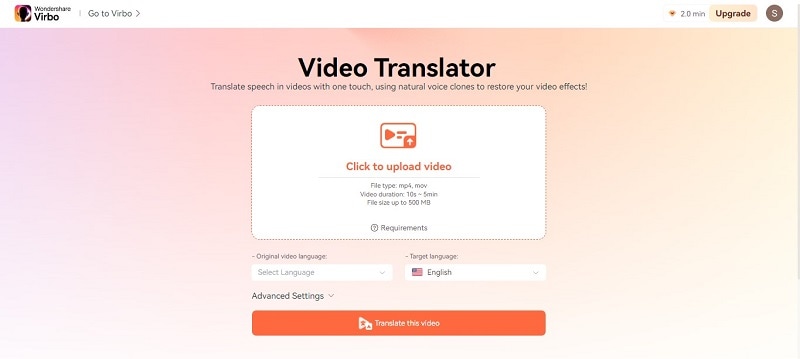
- Step 3: Specify Japanese as the Original video language and English as the desired Target language.
- Step 4: Virbo offers Advanced Settings to customize the translated view result. Toggle on the Lip-sync, Subtitle, and Proofread video script switches to enable them when needed.
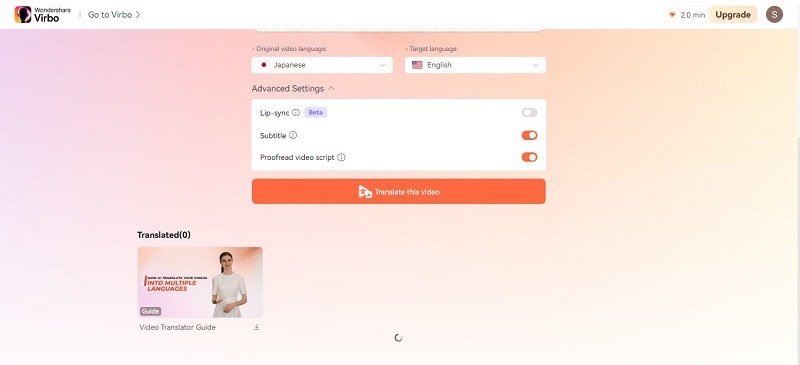
- Step 5: Click Translate this video to start the translation process once everything is set.
- Step 6: Wait a few moments while Virbo performs video transcription. Review the text and edit if needed.
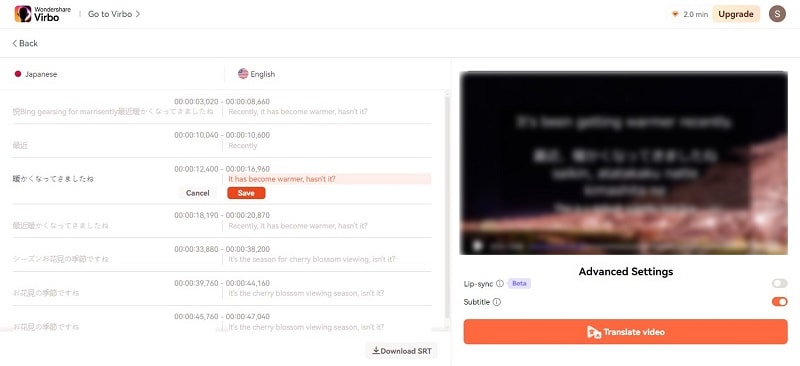
- Step 7: Click Translate video to proceed, then the video will go to the queue.
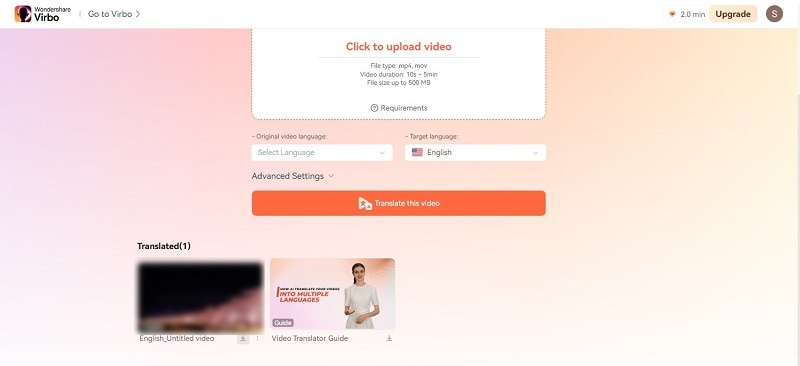
- Step 8: After completion, you can preview the translated video before downloading the final English version.
Part IV. How To Achieve the Best Video Translation Results?
You can’t always translate a video from Japanese to English without a few difficulties. Here are some ways to make the process easier for you:
Divide the Script Into Manageable Chunks
Break down the script into smaller sections like sentences, phrases, or even shorter segments depending on the video’s pace and complexity. It allows for more precise timing adjustments later.
Use a “Shadowing” Technique
As you watch the video, read the translated text out loud. Adjust the subtitle timing to match how you naturally speak. Doing this makes the flow feel more natural for you and the viewers.
Test and Refine
Now that you’ve set the timing for the subtitles, it’s time to put them to the test with your target audience. This step is important because it helps you catch any timing problems, awkward phrasing, or cultural differences that might have slipped through during editing.
Listen to what your audience says, and then use that feedback to tweak the subtitles. Your goal is to make sure they’re clear, short, and match the audience’s culture.
AI for Pre-Translation Tasks
Take advantage of AI tools for speech-to-text conversion and automatic subtitle generation. It can save time, but always proofread for accuracy and natural flow.
File Compatibility
Ensure your chosen translation service or tool supports the format of your video file. The common formats include MP4, MOV, and AVI.
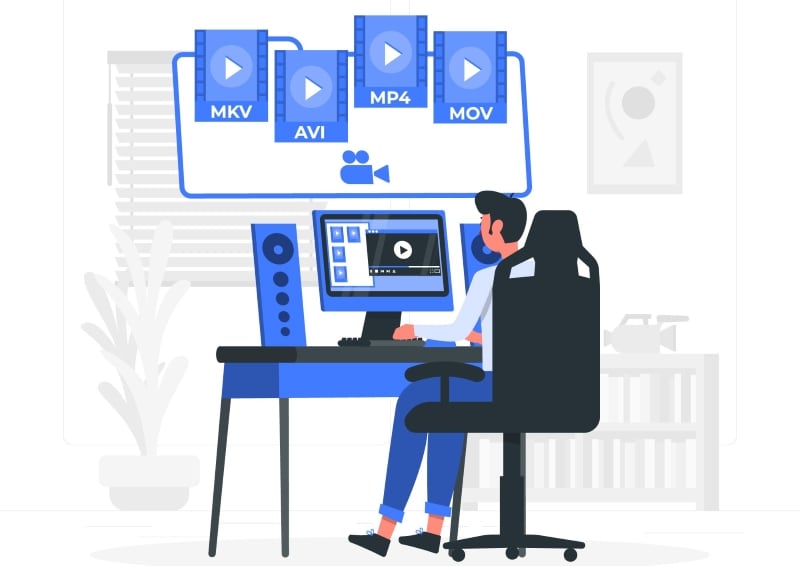
Conclusion
So you’ve seen how easy it can be to translate a video from Japanese to English. It’s up to you whether you will ask for the help of human translators, video editors, or AI video translators.
As you know, Virbo goes beyond being a basic Japanese to English video translator and converter. It takes the complexity out of translation, offering seamless and accurate results.
But remember, even the best AI translation can benefit from a human touch. Don’t be afraid to experiment and refine your translated video for the best outcome. With a little effort, you can bridge the language barrier and share your Japanese video content with the world.
Let’s say you’re a business owner or a content creator in Japan. If you want to broaden your horizons, you may need to translate videos from Japanese to English. This is because English is spoken globally. You can sell more, share knowledge, and connect with English speakers worldwide.
For streaming platforms, turning Japanese content into English is a ticket to reaching audiences all over the globe. And businesses using Japanese tech might need translated training videos for their remote workers.
Seeing this growing need, it’s clear you need effective video translation solutions. So, we’ve created a guide to help you choose the best method for each step, including using AI. Finding the right way to translate videos is important, so keep reading!

Part I. Completed Process To Translate Videos From Japanese to English
When you want to translate a video from Japanese to English, you can follow some general steps, no matter how you decide to do it. Let’s break down each step for you:
- Step 1: Video Transcription
Before you can translate, you need to understand what’s being said. So, the initial step is to do a video transcription. You can either hire professionals or use a Japanese-to-English video translator app to convert the spoken language to text.
Transcription captures all the Japanese dialogue, ensuring the English translation is spot-on. Having the text file lets you edit it, like shortening sentences or adjusting cultural references. This results in a smoother and more natural English video for you.
- Step 2: Translation
Once you have the transcript, you can translate the Japanese text into English. A good translation ensures the original message is accurately conveyed in the new language. It avoids any misunderstandings or misinterpretations for your English viewers. You have two options to do it. Both have strengths and weaknesses, so let’s see which suits your needs best.
- Professional Human Translation Services
When you want to translate a video from Japanese to English, a pro can make the sentences sound right for your audience. These professionals tweak the tone to be natural and engaging. If you go to translation agencies, they make sure the work is top-notch by going through strict editing and reviewing. However, human translation services cost more and take a bit more time than machine translation tools.
- Machine Translation Tools
Machine translation tools are fast and affordable. They can be a good option for short, simple videos where perfect accuracy isn’t critical. But it often struggles with complex language, cultural references, and humor.
- Step 3: Timing and Implementation
Let’s talk about making the Japanese to English video translation seamless. After translating, you want the words to match the original rhythm and pace of the speaker in the video. It keeps things feeling natural and engaging for you, the viewer. Plus, speakers use non-verbal cues like jokes, emotions, and pauses. Matching the translated text with these visual cues keeps the video’s meaning and impact intact.
How to do it? Professional workflows often use timecode, which gives each video frame a unique timestamp. It ensures super precise subtitle placement for that perfect synchronization. Some video editing tools even have “waveforms” to help visually line up subtitles with the spoken parts.

Here are several ways to add the translated Japanese text to your video:
- Subtitles
Subtitles are like on-screen translators for you. They show the English dialogue while the original Japanese audio goes on. It helps you understand if you get the visuals but not the language. The focus is on getting the main point across and sometimes making the sentences shorter for easier reading.
- Closed Captions
Like subtitles, closed captions (CC) are words shown on the screen. They go beyond spoken words, covering all the sounds you hear, like dialogue, music, and even background noises. The main goal is to help you, especially if you’re deaf or struggle with hearing. So, if you’re aiming for videos everyone can enjoy, try a video translator from Japanese to English with CC capabilities.
- Dubbing
Dubbing is a more intricate process where the original Japanese audio track is completely replaced. Voice actors step in to record the translated script in English. They try to sync up their words with the lip movements of the characters on screen. It makes it seem like the characters speak English right from the start, giving you a more immersive viewing experience.
- Voiceover
In this method, a narrator reads the translated script in English over the original Japanese audio. It’s often used in documentaries or educational videos when you need more info beyond just the dialogue.
- Step 4: Final Review and Approval
Alright, so you’re at the last step now. You’re giving the translated video a good check to ensure everything’s spot-on – accurate, consistent, and top-notch quality. It means looking out for any problems in the translation, timing, or how you choose to do it. Once you give the thumbs up to the final version, you’ve got a smooth and effective English video ready for your audience.
You might find the previous steps tedious and time-consuming. But what if you could translate your video from Japanese to English in minutes? That way, you could reach new markets and expand your influence faster. AI video translators like Wondershare Virbo can help you spread your work, passions, and stories to a global audience. Read on to learn more.
Part II. Virbo: Realistic AI Japanese to English Video Translator
You’re excited about your new product, but your explainer video feels like it’s only speaking to half the world. You know the potential exists, but the language barrier holds you back. Or perhaps you’ve captured stunning footage from your recent trip to Kyoto, but sharing it with your followers feels like a lost cause.
Here’s the deal: you don’t have to stick to a small crowd.

Get Started Online Free Download
Virbo uses the latest AI tech to automatically translate, dub voice, and add synced subtitles to your Japanese video. This app is simple to use and can translate video content into over 20 languages. Virbo translates Japanese to English videos in a few minutes – all free for videos under 2 minutes!
Here’s what makes Virbo stand out:
- Precise Lip-sync: Say goodbye to awkward, out-of-sync translations. Virbo AI video translator ensures the translated dialogue seamlessly matches the speaker’s lip movements and facial expressions, creating a natural and engaging experience (still in beta, but getting better every day!).
- AI Cloning Voices: Add engagement with Virbo’s AI-cloned voices that capture the essence of human speech. Choose from a range of natural-sounding voices that express the right emotions and add personality to your content.
- Soundtrack Reserved: Don’t lose the original soundtrack that sets the mood. Virbo allows you to keep it intact, enhancing its impact even in different languages.
- Versatile Compatibility: Virbo works across various platforms, including Windows, iOS, and Android. You can even use it online for ultimate flexibility.
- Affordable Excellence: Experience the power of AI video translation without breaking the bank. Virbo offers high-quality solutions at affordable prices, making them accessible to everyone.
Part III. How To Translate Japanese to English Video Using Virbo Automatically
Using Virbo AI video translator can help you be more productive. Here’s how to translate a video in Japanese to English online for free:
- Step 1: Go to Virbo AI video translator online from your browser for quick access. You can also download the app for your desktop. Once you’ve chosen your access point, sign in using your existing Google, Facebook, email, Apple, or Twitter account.
Get Started Online Free Download
- Step 2: Choose and upload your Japanese video file from your local storage. Ensure the video is between 10 seconds to 5 minutes long and in MP4 or MOV format, up to 500 MB for optimal processing.

- Step 3: Specify Japanese as the Original video language and English as the desired Target language.
- Step 4: Virbo offers Advanced Settings to customize the translated view result. Toggle on the Lip-sync, Subtitle, and Proofread video script switches to enable them when needed.

- Step 5: Click Translate this video to start the translation process once everything is set.
- Step 6: Wait a few moments while Virbo performs video transcription. Review the text and edit if needed.

- Step 7: Click Translate video to proceed, then the video will go to the queue.

- Step 8: After completion, you can preview the translated video before downloading the final English version.
Part IV. How To Achieve the Best Video Translation Results?
You can’t always translate a video from Japanese to English without a few difficulties. Here are some ways to make the process easier for you:
Divide the Script Into Manageable Chunks
Break down the script into smaller sections like sentences, phrases, or even shorter segments depending on the video’s pace and complexity. It allows for more precise timing adjustments later.
Use a “Shadowing” Technique
As you watch the video, read the translated text out loud. Adjust the subtitle timing to match how you naturally speak. Doing this makes the flow feel more natural for you and the viewers.
Test and Refine
Now that you’ve set the timing for the subtitles, it’s time to put them to the test with your target audience. This step is important because it helps you catch any timing problems, awkward phrasing, or cultural differences that might have slipped through during editing.
Listen to what your audience says, and then use that feedback to tweak the subtitles. Your goal is to make sure they’re clear, short, and match the audience’s culture.
AI for Pre-Translation Tasks
Take advantage of AI tools for speech-to-text conversion and automatic subtitle generation. It can save time, but always proofread for accuracy and natural flow.
File Compatibility
Ensure your chosen translation service or tool supports the format of your video file. The common formats include MP4, MOV, and AVI.

Conclusion
So you’ve seen how easy it can be to translate a video from Japanese to English. It’s up to you whether you will ask for the help of human translators, video editors, or AI video translators.
As you know, Virbo goes beyond being a basic Japanese to English video translator and converter. It takes the complexity out of translation, offering seamless and accurate results.
But remember, even the best AI translation can benefit from a human touch. Don’t be afraid to experiment and refine your translated video for the best outcome. With a little effort, you can bridge the language barrier and share your Japanese video content with the world.
How To Convert Video Voice to Text Online for Free?
Do you ever struggle to understand or keep up with long videos? Maybe you need the information in text format for easier note-taking or sharing. However, transcribing the video content manually can be a time-consuming task.
The good news is that you can easily convert video voice to text online for free. In this guide, you’ll explore several ways to do it using the best tools and some tips if you encounter any issues. So, whether you’re dealing with online meetings, e-learning content, or working on global campaigns, this article has a solution for you. Let’s start.

Part 1. For Online Meetings on Desktop: Convert Video Voice to Text by Descript
Joining online meetings might get tricky when crucial details slip by because of fast speakers or background noise. Don’t worry – Descript has your back. It is a versatile video recorder that doubles as a video voice-to-text converter online.
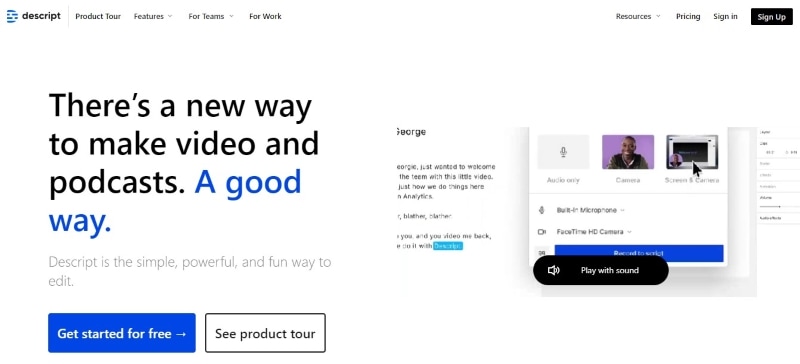
With Descript, you can easily review key points, find specific moments, and share the transcript with colleagues who couldn’t make it. Say goodbye to missed details and hello to smoother online meetings with Descript.
How To Convert Video Voice to Text Automatically Using Descript?
With Descript, online meetings become active and focused. Ready to give it a try? Follow these steps below to convert your recorded video to text files online with Descript:
- Step 1: Launch Descript from your web browser and create an account.
- Step 2: Click + New in the top right corner of the Projects on the home page. Then, go to Video project > Add file, and select your video file from the pop-up window.
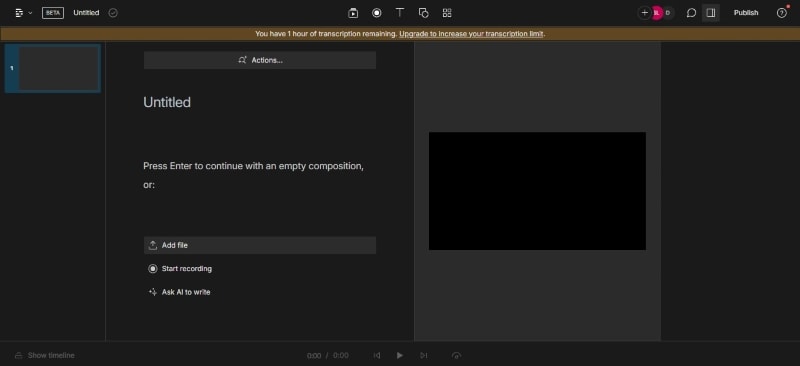
- Step 3: Descript will automatically begin transcribing your video once it’s uploaded.
- Step 4: You’ll see the converted text on the left. Just click on it to make any changes you need.
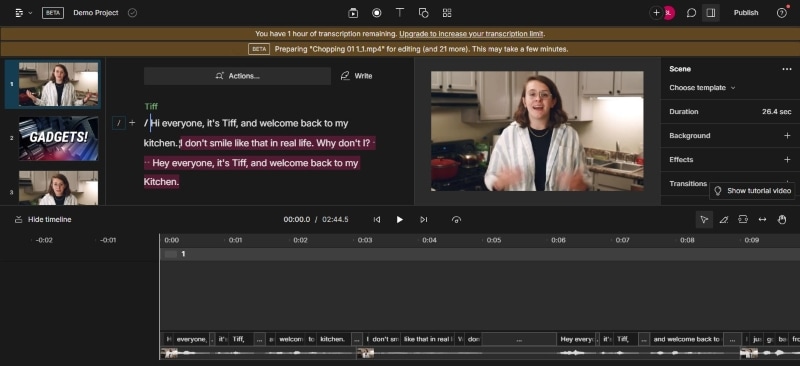
Tips:
Click the “**Actions…” button on the text editor and select “Remove filler words…**” to search and delete filler words in the text automatically.
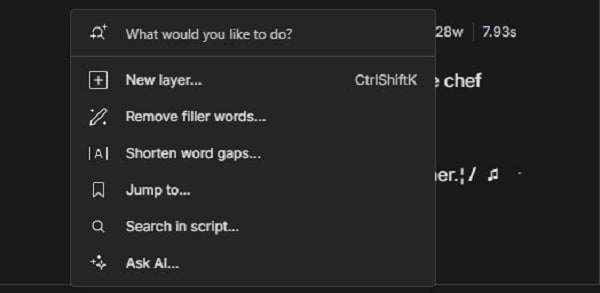
- Step 5: Once you’re happy with the transcript, you can export it in various formats. Go to File in the top navigation pane and select Export.
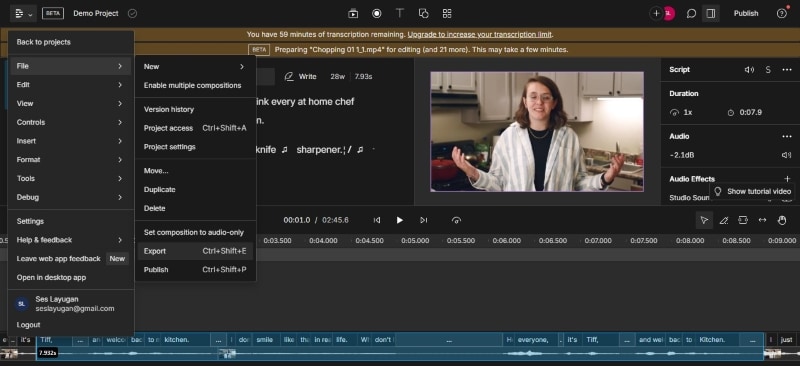
- Step 6: Go to the Transcript tab bar from the pop-up window. Choose the desired format (TXT, DOCX, etc.) and customize the export settings.
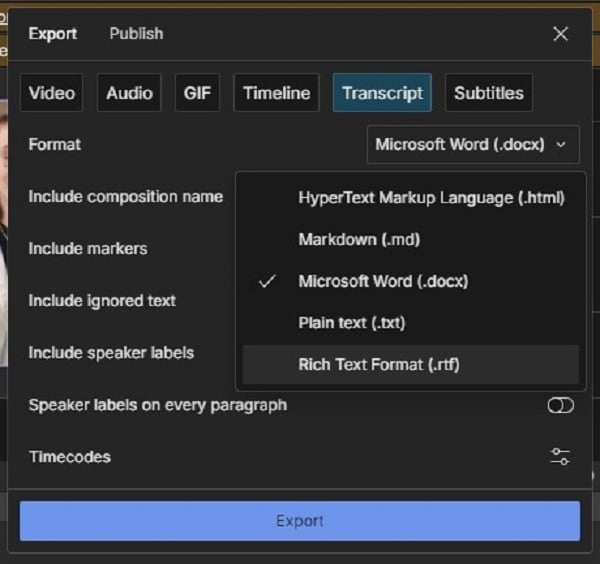
Part 2. For E-Learning Online: Convert Video Voice to Text by Happy Scribe
Getting new skills through e-learning is great, but listening to long video lectures can be tiresome. But with AI tools like Happy Scribe, it is easier to study. It has an intuitive interface and lets you convert video voice to text online for free.
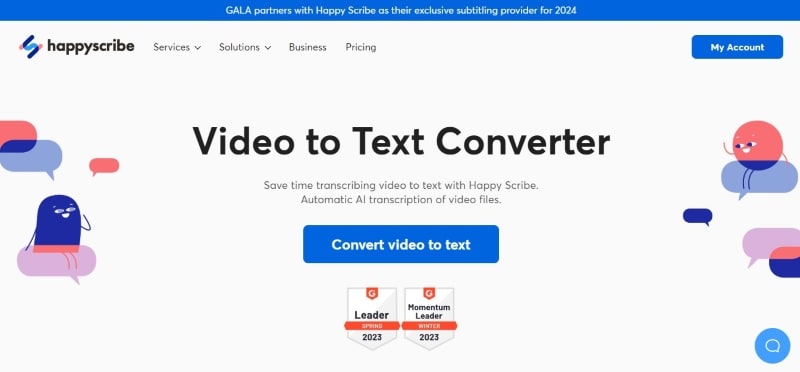
Happy Scribe’s AI transcribes your video, whether pre-recorded or from YouTube, giving you a text version of the lecture. Now, you can review the important things at your speed and find specific info faster.
How To Convert Video Voice to Text Using AI With Happy Scribe?
You can use Happy Scribe as a YouTube video voice-to-text converter online. The first 10 minutes are free; you can try it out for short videos or snippets. Here’s how to use Happy Scribe for video transcription online:
Step 1: Head to Happy Scribe’s website and log in to your existing account. If you’re a new user, sign up for a free account.
Step 2: Choose the upload source:
Click Upload a fileand select your video from your desktop folders.
Paste the public video URL from YouTube, Google Drive, and more into the designated field.
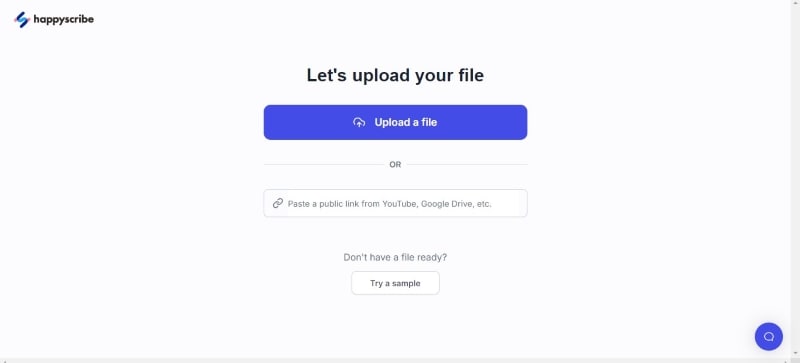
- Step 3: A pop-up window will appear once you’ve chosen the upload source. Choose the language spoken in your video from the dropdown menu. Then, select Machine generated as the transcription method.
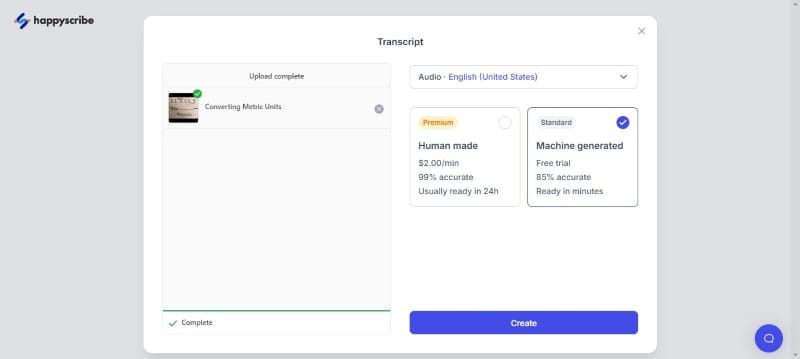
- Step 4: Click Create after setting your options. Happy Scribe YouTube video voice-to-text converter online will upload and process your video.
- Step 5: Happy Scribe will automatically generate a transcript. Use the built-in editor to click on any section of text to edit and correct mistakes. You can also control playback speed to make editing easier.
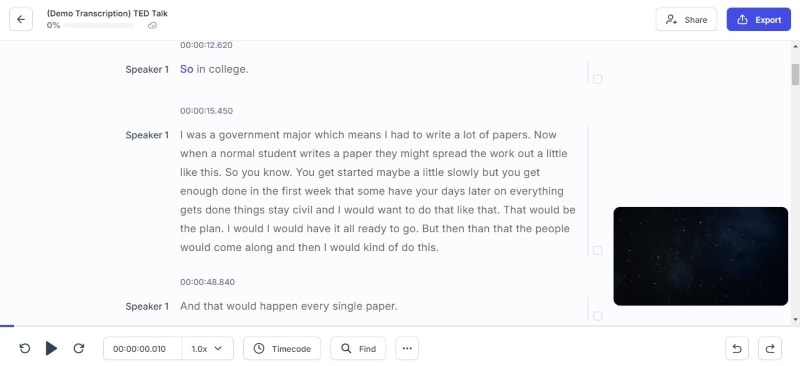
- Step 6: Once done editing the transcript, click Export from the upper right navigation pane. Since you are using the app for free, you can download it in text document and SRT file formats. Click Export 1 file to save the transcript to your computer.
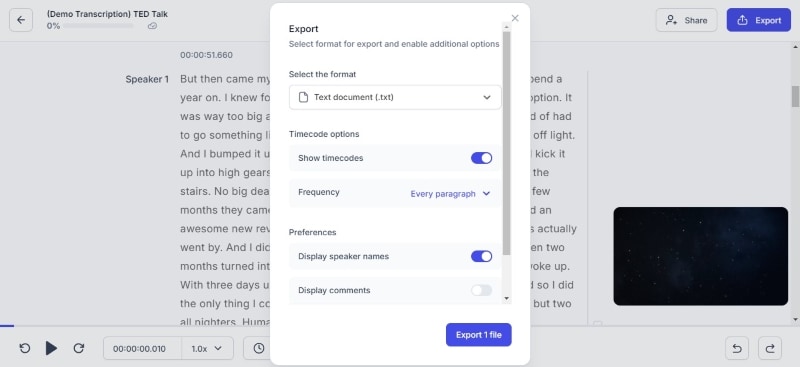
Moving beyond desktop meetings and e-learning, businesses often need an easier and faster way to translate video content for a global audience. That is where AI video translation can help you. In the next part, you’ll explore how Wondershare Virbo can help you efficiently translate video voice to text in multiple languages. Read on to make your marketing materials accessible to a wider audience.
Part 3. Virbo: Best Video Voice-to-Text Translator Online for Global Marketing
When taking your brand global, language barriers can be a challenge. But here’s the good news: with Virbo, it’s doable. One of its highlights is the ability to accurately translate video voice to text.
Virbo makes global marketing easier.

Get Started Online Free Download
This app uses AI to transcribe your video’s audio into text. Then, it lets you translate that text into different languages. Want to go the extra mile? Add these translated captions to your video, and voila! You’ve made your content accessible to viewers worldwide. This way, you can create professional, multilingual video content that expands your reach and increases brand recognition across borders, all within a single platform.
Here’s what makes Virbo the best video voice-to-text translator online for your global marketing endeavors:
- **Support for 20+ Languages:**With Virbo, you can translate video voice to text in different languages, including popular choices like Spanish, English, Chinese, and more.
- **Cross-Platform Compatibility:**Marketing knows no borders, and neither does Virbo. Whether you’re a seasoned techie or a casual user, Virbo seamlessly adapts to your workflow. It works on Windows desktops, iOS, and Android devices and even directly on your web browser.
- **Easy To Use:**Virbo understands that time is precious, especially in business. That’s why it boasts an intuitive interface that anyone can navigate easily.
- **High-Quality Output:**When it comes to your brand message, clarity is paramount. Virbo ensures your translated content maintains its original meaning and impact. Its high-quality translation output guarantees your message resonates with your global audience just as intended.
- Budget-Friendly App: Reaching a global audience shouldn’t break the bank. Virbo offers its powerful features at an affordable price, making it an excellent choice for businesses of all sizes. Now, you can translate video voice to text without worrying about hefty costs.
How To Translate Video Voice to Text Automatically Using Virbo AI?
Virbo offers free video translation with subtitles, up to 2 minutes per video. Here’s how to translate video voice to text online in a few easy steps:
- Step 1: Click Translate Video Online from the Virbo video translator webpage. You can also download the app on your desktop. Then, create or login to an account.
Get Started Online Free Download
- Step 2: Upload your video file in MP4 or MOV format. Select the language spoken in your video from the dropdown menu. Then, choose the language you want the subtitles for and translate the text into. Click Translate this video to continue.
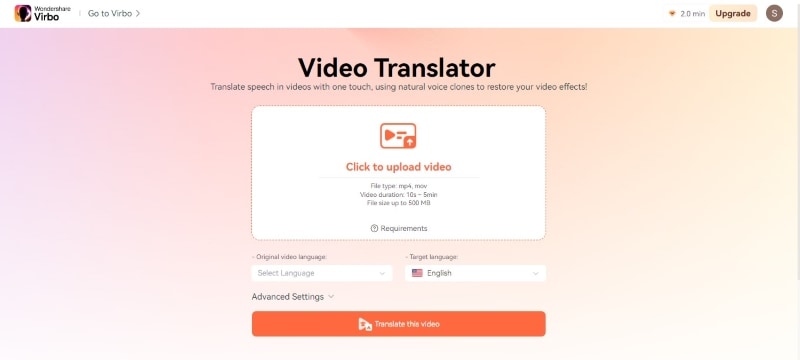
Tips:
Advanced Settings (Optional):
- **Subtitle:**Enable this to generate subtitles in the target language based on the transcribed text.
- **Proofread video script:**This allows reviewing and editing the transcribed text before translation.
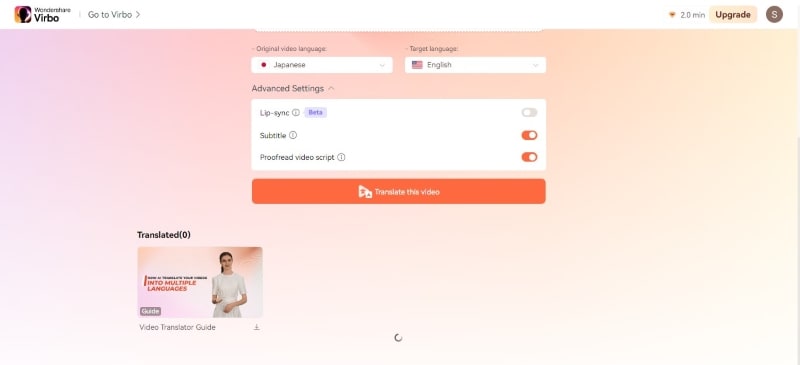
- Step 3: Virbo will process your video. This may take some time depending on the video length.
- Step 4: Review and edit any errors on the text editor before proceeding. Once satisfied, download the subtitles file (SRT format).
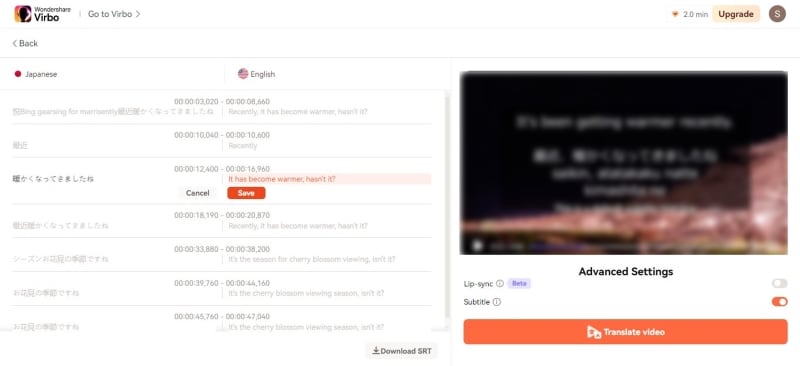
- Step 5: Click Translate video to add the translated text or subtitle to your original video. After processing is complete, Virbo will provide you with a preview of the translated video with subtitles (if enabled). If you’re satisfied with the results, click the Download icon to save the translated video with subtitles to your computer.
Part 4. Troubleshooting Issues When Converting Video Voice to Text
Creating clear and accurate transcripts is essential for professional settings. Here’s how to avoid common pitfalls that can impact transcription quality:
Issue 1: Background Noise
Solution: Noisy recordings can cause problems with transcription accuracy. Luckily, many video editing programs have noise-reduction features. Running your audio through one of these before conversion can make a big difference.
Issue 2: Accents or Dialects
Solution: Most speech recognition software is good these days, but accents and dialects can still trip them up. Check your software’s settings for options to adjust the recognition model. Some programs even let you upload a sample of the speaker’s voice to improve accuracy.
Issue 3: Punctuation Errors
Solution: Some software offers built-in punctuation correction you can use. If unavailable, find a separate grammar tool after conversion. Always proofread the transcript yourself for any missing punctuation.
Issue 4: Overlapping Voices of Speakers
Solution: If the video has multiple speakers, try software that can differentiate voices. This includes interviews and panel discussions. You can always transcribe each speaker’s section if that’s not an option. Then, add timestamps to identify speaker changes in the transcript.

Issue 5: Inconsistent Transcription Format
Solution: Most video-to-text software allows you to format after the converter generates the transcript. You can adjust fonts, add paragraph breaks, and even format speaker identification within the program. Also, you can always export the transcript to a word processor for in-depth formatting.
Conclusion
You learned several ways to convert video voice to text online for free and the best apps for it. These tools make videos easier to understand, whether recorded or uploaded from websites like YouTube.
Now, you also know the best app to translate video voice to text. Virbo allows you to translate your videos into different languages using AI, making your content global. So, explore these tools, see how video text conversion helps, and choose the app that fits you best.
Create Lip Sync TikTok Videos Without Installing Any App
TikTok has transformed the social media landscape through its short-form video content. They encourage users to make creative content using popular audio clips. Which enables them to entertain, gain recognition, and contribute to the platform.
Lip-syncing is a big part of what makes TikTok popular. Many users post lip-syncing videos that imitate voices from songs, movies, or trending audio clips. This art of lip-syncing has become an essential element of TikTok’s culture. Now, you might wonder how to lip-sync on TikTok videos. This article will teach us how to make it effortlessly.
Part 1. Why Do People Lip Sync on TikTok?
Lip-syncing involves mimicking the words or vocals of an existing audio track. TikTok users take this concept to new heights by lip-syncing popular songs or clips. Lip-sync is appealing because it lets people get creative and reach a large audience.
Here are a few reasons why people engage in lip sync TikTok:
- Self-expression: Lip-sync allows users to embody their favorite artists or characters by showcasing their personality and creativity.
- Entertainment: Many users lip-sync to entertain followers. They offer comedic performances, heartfelt renditions, or engaging storytelling.
- Virality: TikTok’s algorithm favors engaging content and well-executed lip-sync videos. They have the potential to go viral, rapidly gaining likes, shares, and followers.
Part 2. How to Make Lip Sync Video on TikTok
Here’s the step-by-step guide on how to lip sync on TikTok and captive your followers:
- Step 1. Open the TikTok app and tap the “+” button.
Start with opening the TikTok app on your phone. Then, tap the “+” button at the bottom of your screen to make a new video.
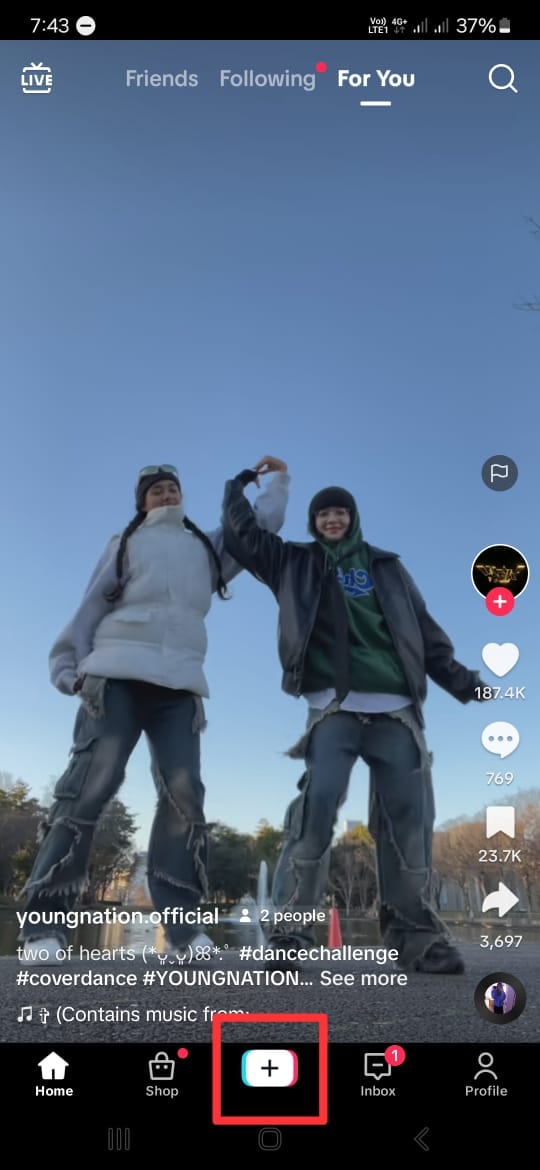
- Step 2. Add a song that you want to lip-sync to.
Next, click “Add Sound” with the musical note icon at the top of the screen. If you have a specific song in mind, you can find it by searching it on the search tab. Then, tap the song and click the check icon beside it.
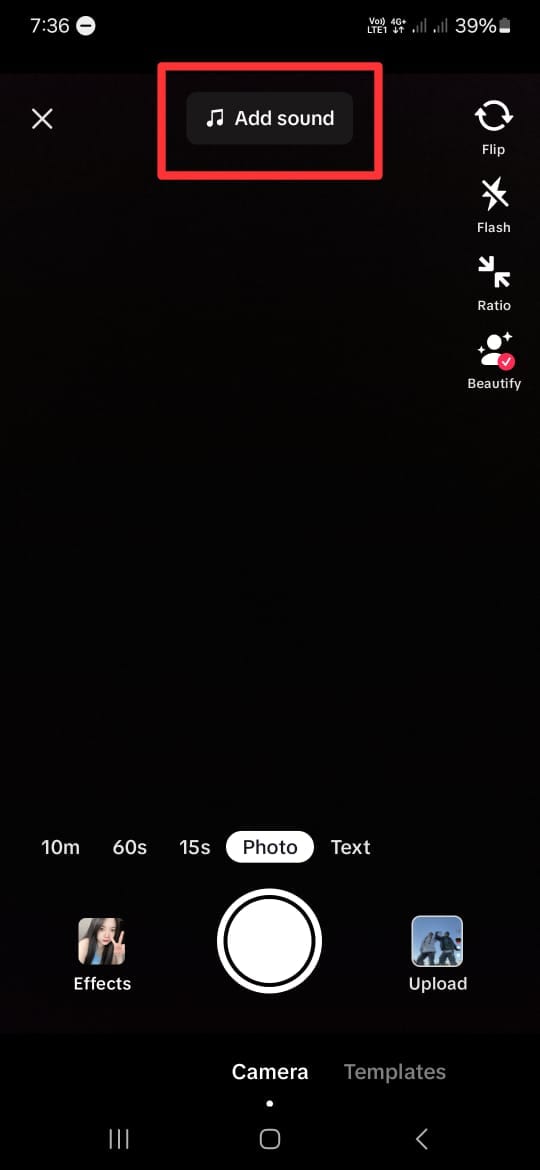
- Step 3. Choose the duration and the part of the song.
After choosing the song you want, you will return to the recording screen. Here, select your video duration at the bottom of the screen. You can choose between 10 minutes, 60 seconds, and 15 seconds. Remember that the duration of the songs on TikTok is usually only 30 to 60 seconds.
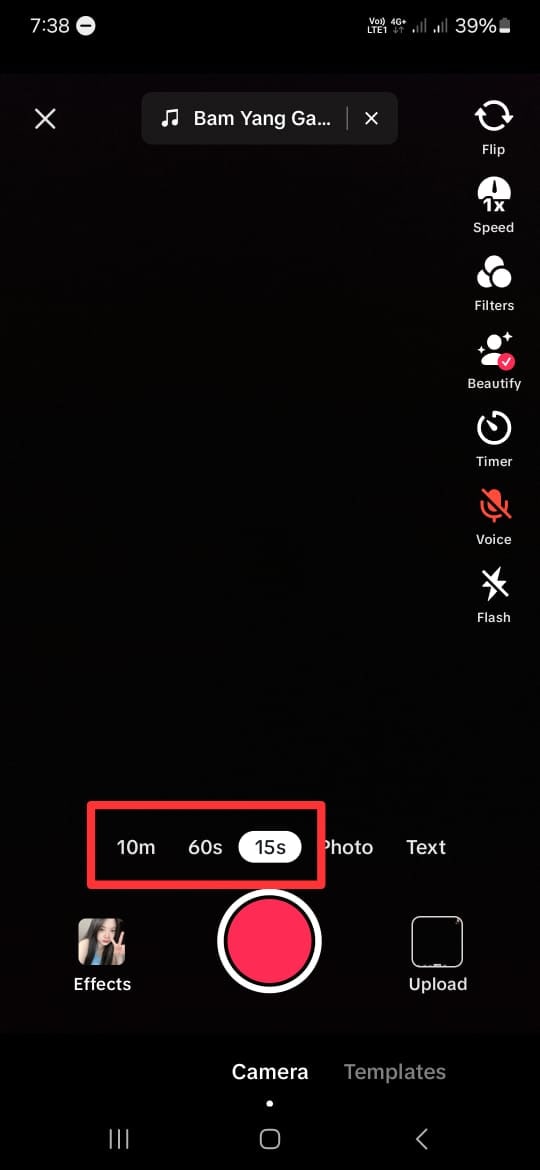
- Step 4. Choose the part of the song.
TikTok allows you to change the part of the song when lip-sync. However, the duration of the video should be less than the duration of the chosen song.
To do this, click on the song’s name at the top of your screen. Then, the bottom of your screen will display your chosen song. Tap the scissor icon and slide the playback to change the part of the song. Click “Done” once you have finished editing.
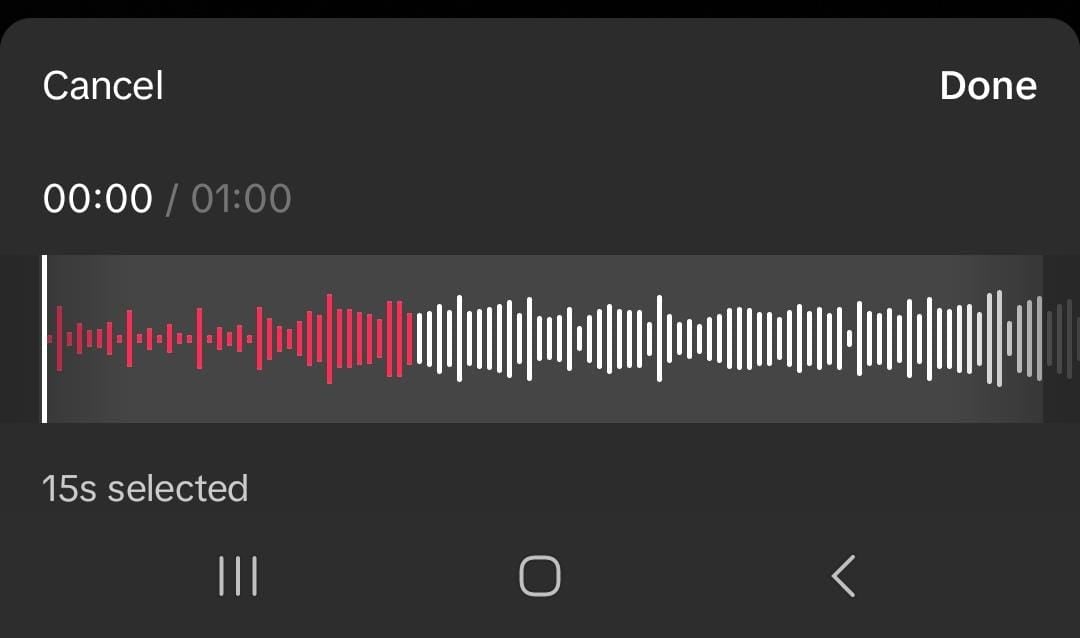
- Step 5. Tap on the red button.
If you are ready to record, tap the red button at the bottom of your screen. Then TikTok will play the chosen part of the song and record your lip-sync simultaneously. You can pause and continue the recording by clicking the same red button.
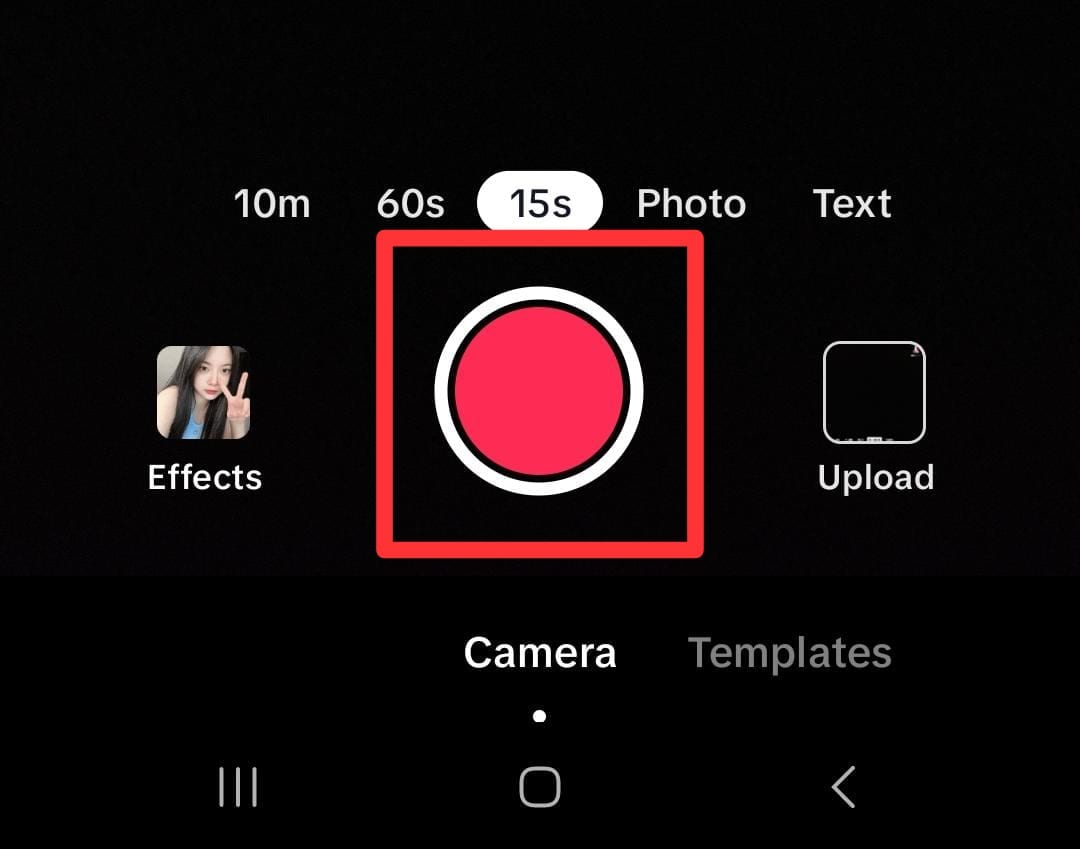
- Step 6. Post the video.
If you are satisfied with the results of your edits, click Next to proceed to the posting stage. Here, you can write a description and any other information you want. Click Post to share your lip-sync video to TikTok.

Creating a video on TikTok by lip-syncing is a fun and creative way to express yourself and connect with others. By following the steps above, you can create a lip-sync video on the TikTok app with ease. Keep in mind that by using these steps, you need to memorize the sentences and understand the beat of the chosen songs.
Part 3. How to Make Lip Sync Video Without Memorizing the Words
Making a TikTok lip-sync video can be challenging because you must remember and match the words with the music. But there are three simple methods to make it easier.
Method 1: Record at slower speed
You can slow the speed down while recording instead of trying to keep up with the song. This technique lets you hear, understand, and follow the words more easily.
Here’s how to slow down the recording:
- Step 1. Follow steps 1 to 4 from the step-by-step guide in Part 2.
Start by following the first to fourth steps from the guide in Part 2 above.
- Step 2. Set the speed record slower.
On the recording screen, click on the Speed icon on the right side of the screen. To make it slower, choose 2x or 3x. This step will make your recording time 2 or 3 times longer than it should be.
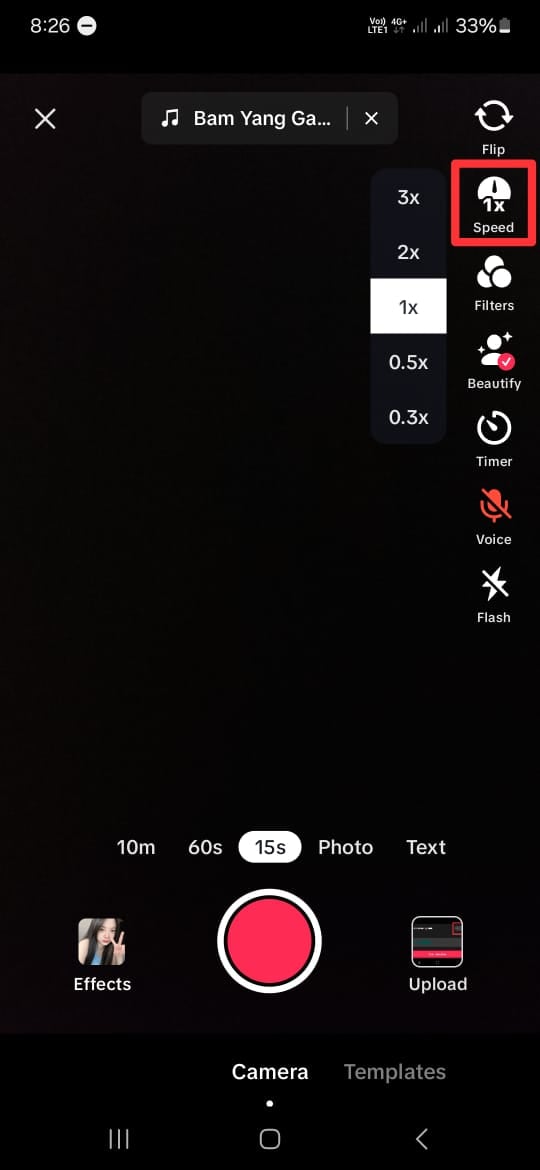
- Step 3. Tap on the red button.
Once you tap the red button, TikTok will play the song slower and record your lip-sync simultaneously. Repeat this step to help you memorize the lyrics and the beat of the songs.
Once you’re comfortable, switch back to normal speed for the final recording. This method will save time and improve accuracy.
Method 2: Purposely delay mouthing the words
While lip-syncing videos may vary in style and pacing, this technique can prove particularly useful for slower rhythms. Moreover, mastering the art of mouth sync on TikTok can elevate the overall production value of lip-syncing videos.
Using the timer feature will give you a slight lag between lip movements and audio playback. Then, it lets creators ensure more precise synchronization during editing. Here’s how to lip-sync on TikTok more easily:
- Step 1. Follow steps 1 to step 4 from the step-by-step guide in Part 2.
Like Method 1, you can start by following the first to fourth steps from the guide in Part 2 above.
- Step 2. Delay the recording
On the recording screen, click on the Timer icon on the right side of the screen. Here, you can set the timer to 3 to 10 seconds to delay the recording’s start. You can also drag and set the recording limit if you want.
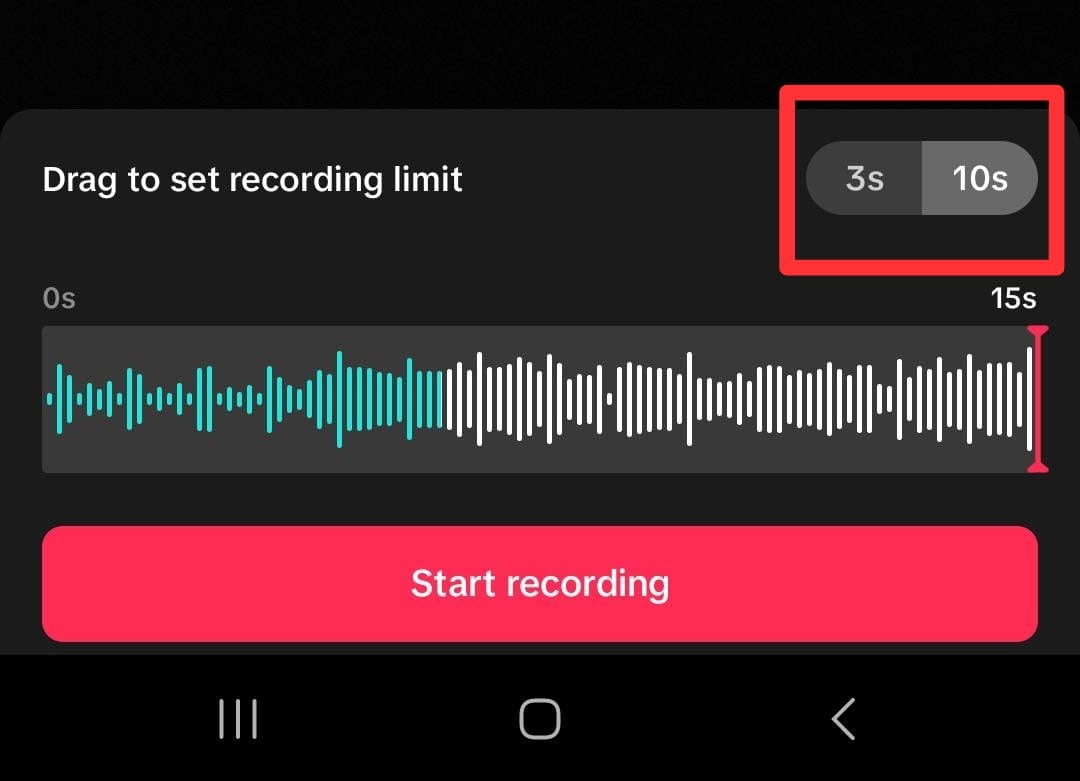
- Step 3. Start the recording
Then click “Start recording” to record the video with the timer on.
Method 3: Use a Photo Talking Tool
Next, consider using a Talking Photo feature by Wondershare Virbo. This method is for you who want to create engaging TikTok lip-sync videos without memorizing the words.
Virbo’s Talking Photo feature tool lets you upload a portrait of your photo and then make it appear as though it is speaking along with the audio. You do not have to install the app because you can use this feature online on their official website.
Here’s how to use Wondershare Virbo - Photo Talking feature to create a TikTok lip-sync video:
- Step 1. Start a new project.
Open the Wondershare Virbo website and tap the talking photo function to start a new project.
Get Started Online Free Download
- Step 2. Upload a portrait.
Tap “Upload Photo”, then upload a picture you want to use by following the instructions.
- Step 3. Edit and export.
Insert the text and adjust the voice settings. If you want to insert your own audio, you can use Wondershare Virbo for mobile or Desktop to upload or record your audio. Then, tap “Generate Video” to export.
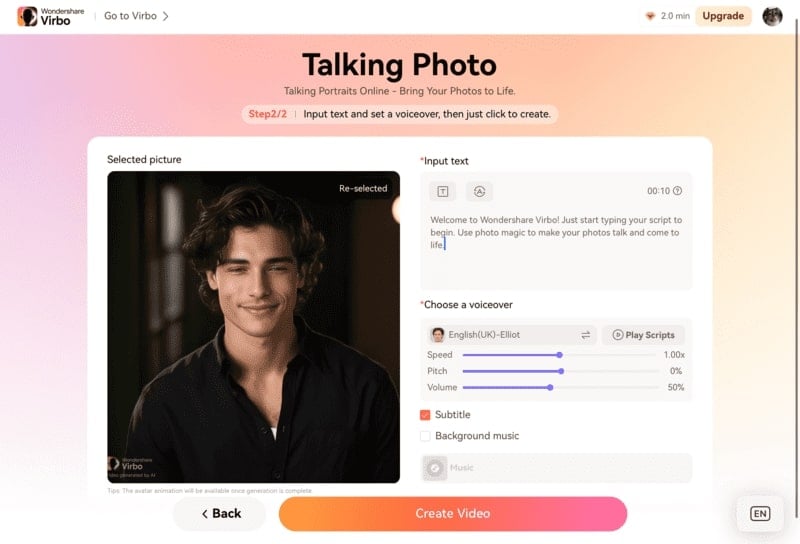
Now, you have successfully made your own TikTok lip-sync video. You can upload it to TikTok and share it with your followers. For more detailed instructions, you can see how to use Virbo’s Photo Talking tool.
Part 4: How To Lipsync Your Video to Any Language Using AI Video Translator
In today’s globalized world, reaching audiences in different languages is important for effective communication. Thanks to technological advancements, there is a tool that can help you translate video content.
Wondershare Virbo – Video Translator offers seamless solutions to translate video content into various languages with AI. Virbo ensures high-quality translations that maintain the integrity and impact of your original message.
How to lipsync TikTok videos to any language with Wondershare Virbo - Video Translator:
- Step 1. Go to Virbo’s official website, then click Generate AI Video Online.
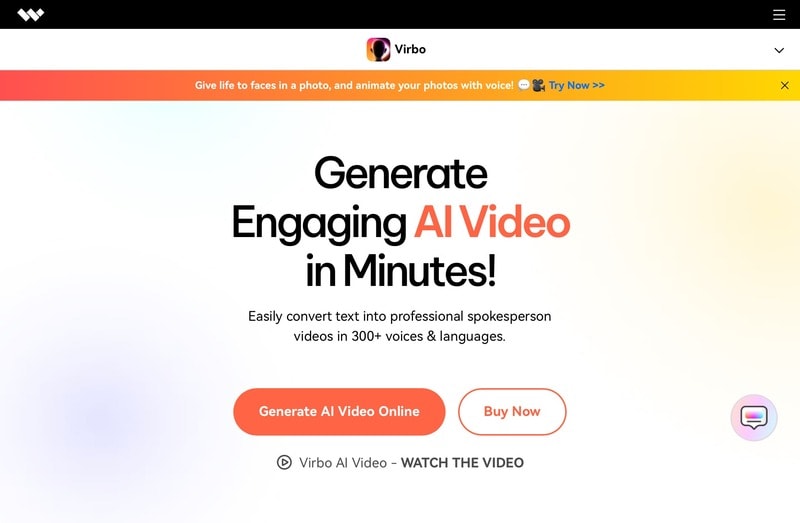
Get Started Online Free Download
- Step 2. Log in or create an account.
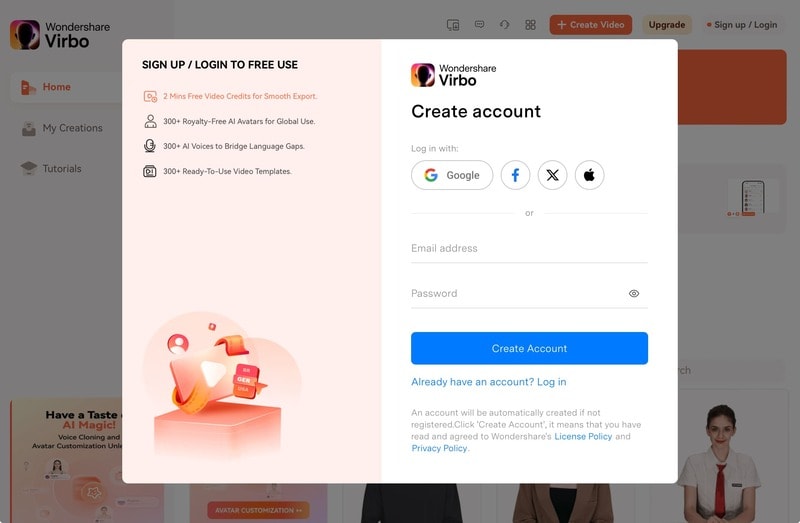
- Step 3. Then, navigate to the Video Translator tool on the Virbo’s homepage.
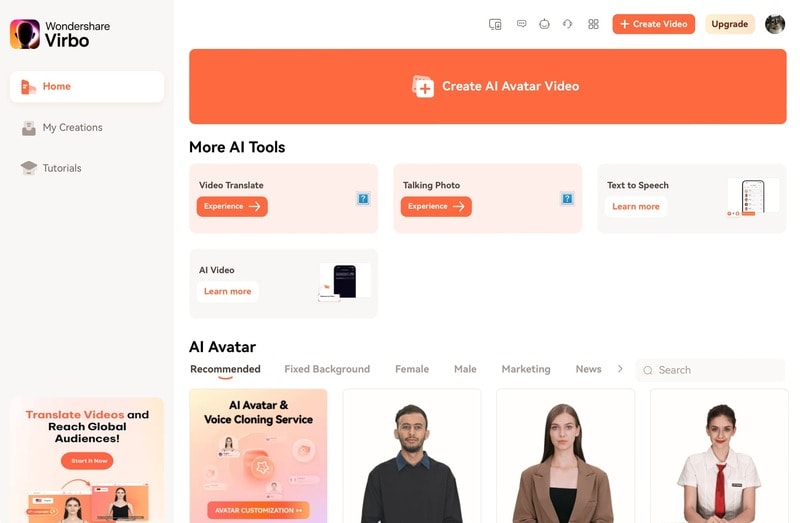
- Step 4. Upload the video.
Once inside the Video Translator interface, upload the video file you wish to translate. Select the original video language and the preferred target language from the available options. Additionally, enable the Lip Sync feature to ensure that the translated audio aligns perfectly with the lip movements in the video.
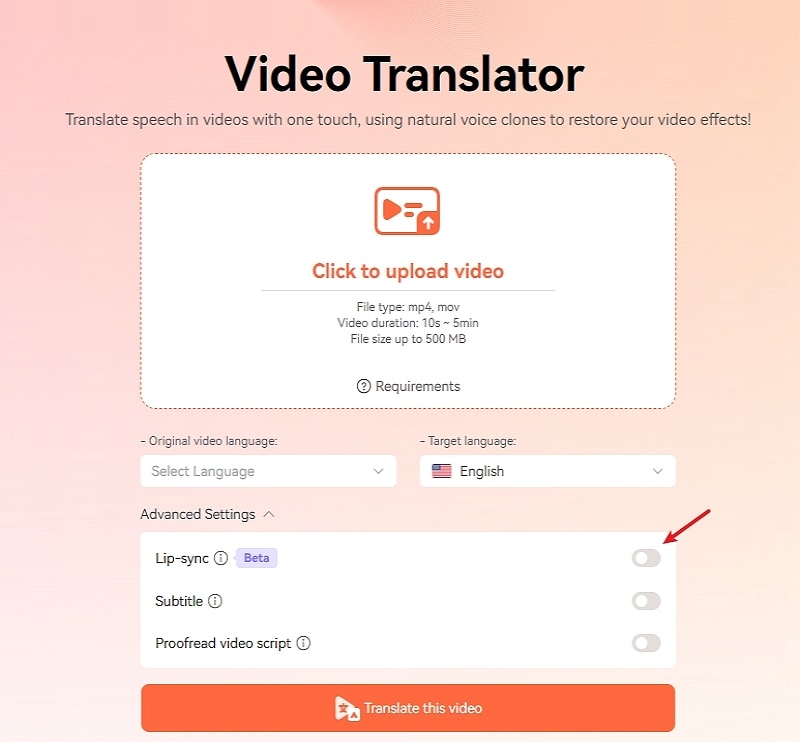
- Step 5. Click “Translate this video” to start translating the video.
Virbo’s Video Translator will use its advanced algorithms to translate the audio and synchronize it with the video seamlessly. Depending on the length and complexity of the video, the translation process may take some time.
Conclusion
Lip-syncing on TikTok has become a significant aspect of TikTok culture. It helps users show their creativity, entertain people, and maybe even become famous. Making mouth sync TikTok videos usually means remembering lines and matching them to music, but there’s an easier way with Wondershare Virbo’s Talking Photo tool. This tool allows you to upload a portrait and sync it with audio without remembering the lines.
Also, Wondershare Virbo has a Video Translator tool that allows you to translate videos seamlessly into any language. This translator tool helps you communicate with people worldwide and maintain the original message.
Also read:
- 2024 Approved Breaking Language Barriers Elevate Your Content with the Best Free Video Translator Apps
- 2024 Approved Mastering Lip Sync Explore Top Apps for Dynamic Videos
- 2024 Approved Selecting the Best Free Melodies for Your YouTube Video
- Complete Guide: Requesting a Game Refund on Steam Platform
- Experience Unmatched Energy Resilience with the DBPower 600A - An In-Depth Look at Its 18,00 Cu Ah Jumpstarter Ability
- How To Change OnePlus 12R Lock Screen Clock in Seconds
- How To Use Special Features - Virtual Location On Realme Note 50? | Dr.fone
- In 2024, Best Toolbox to Translate YouTube Videos to English Subtitles
- In 2024, How To Unlock Any Motorola Moto G84 5G Phone Password Using Emergency Call
- In 2024, Set Your Preferred Job Location on LinkedIn App of your Xiaomi Civi 3 Disney 100th Anniversary Edition | Dr.fone
- In 2024, The Ever-Changing Era of AI Video Translation A Reality to Be Fulfilled
- Netflix Subtitle Translation Methods Comprehensive Guide
- New In 2024, How to Translate TikTok Videos Top 5 Auto Translate Tools
- New In 2024, The Ever-Changing Era of AI Video Translation A Reality to Be Fulfilled
- The Modern Witchcraft Natural Magick Boxed Set | Free Book
- Withholding Information: What's Your Guide to Calling Back Private Numbers?
- Title: Updated In 2024, Step-by-Step Guide How to Translate TikTok Videos
- Author: Susan
- Created at : 2025-02-14 17:46:07
- Updated at : 2025-02-19 17:33:43
- Link: https://ai-video-translation.techidaily.com/updated-in-2024-step-by-step-guide-how-to-translate-tiktok-videos/
- License: This work is licensed under CC BY-NC-SA 4.0.